We’re breaking down the cost of a trip to Japan — from food and hotels to trains and entertainment – to show you exactly how much a trip to Japan costs. We get super detailed so you can work out your perfect Japan travel budget.
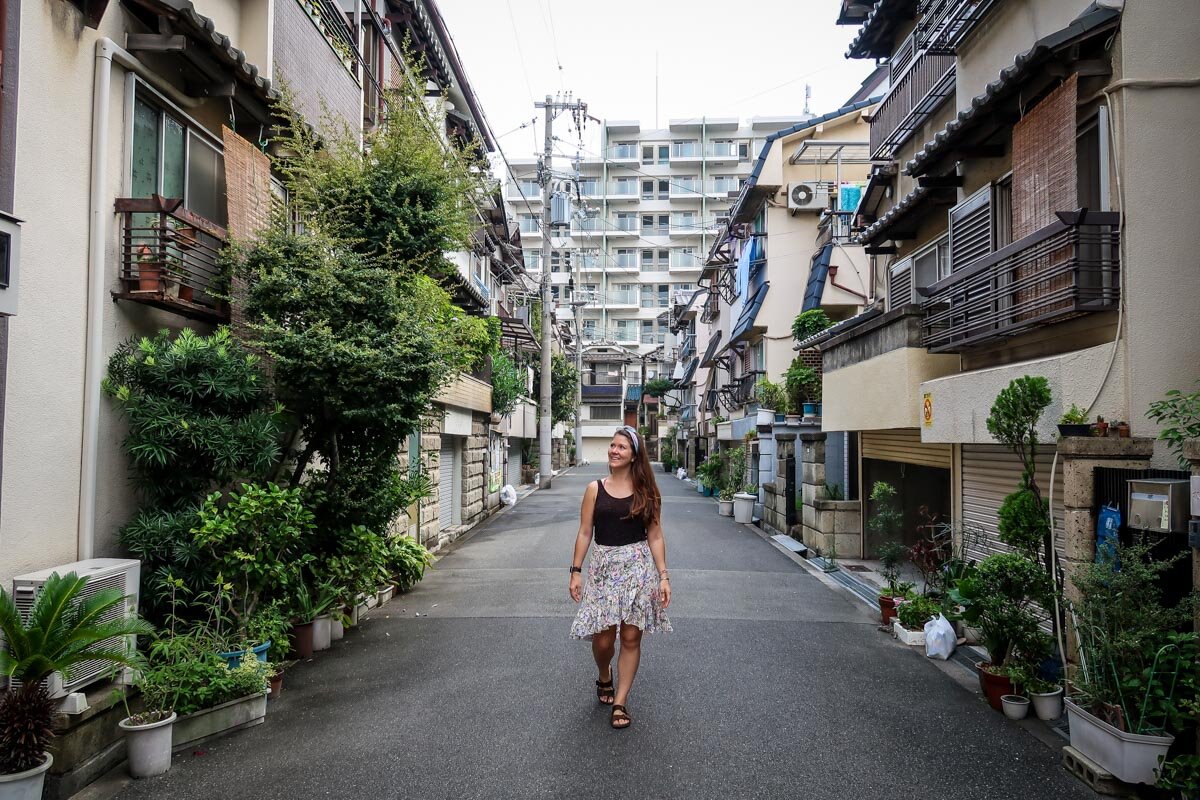
As you start to plan a trip to Japan, you might find yourself fretting and wondering if the rumors are true…
Is Japan expensive? And if so, just how expensive are we talking?
I’m going to give it to you straight: Yes, Japan is an expensive country to travel. Especially when you compare the typical costs to other neighboring countries.
But hold up, I do have some good news…
If you’re starting to sweat and rethink your dream of traveling to Japan, I’m going to hop right in and say that while it’s not super cheap, it is totally possible to travel to Japan on a budget.
Many things in Japan are actually pretty reasonably-priced. And as long as you have realistic expectations and are equipped with a few handy money-saving tricks, you’ll be able to travel to this fascinating country without dipping into your retirement fund.
In this article, we’re sharing our exact Japan travel expenses so you have an idea of exactly how much a trip to Japan costs. We have also personally traveled to Japan several times and have all sorts of practical money-saving tips that’ll help you hang onto those yen.
So buckle up and grab a notebook because we’re about to dive in!
Japan Travel Cost Guide
Bonus sections:
Our personal experience traveling in Japan
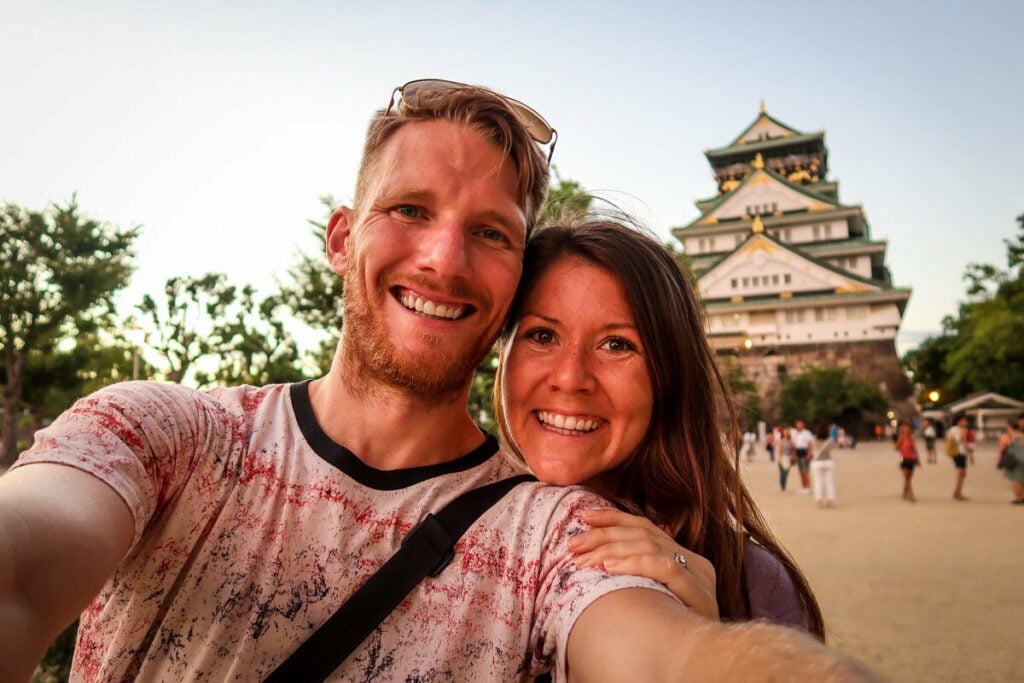
We’ve traveled to Japan three times, each with a slightly different budget:
- The first time (2015), we had 8 days and were on a super tight budget.
- Our second visit (2019) was for 3 weeks, and our budget was a bit more flexible, but still not huge.
- On our most recent trip (2023), we had 3 weeks and a more generous Japan travel budget. We also had our toddler with us, meaning we made choices with her in mind, which alters our budget a bit.
While our budgets were different on each trip to Japan, each one was incredible in its own way. We were able to eat amazing food, have unforgettable experiences, and see iconic Japanese sights.
We proved to ourselves that it really is possible to have an incredible trip to Japan whether you’re working with a very tight budget or you have more wiggle room.
We recorded our actual expenses in Japan, so we have real numbers to share with you in this article.
Good to know: We continue to update this article to reflect the actual current prices in Japan so that you have the most accurate, up-to-date information!
How much is a trip to Japan?
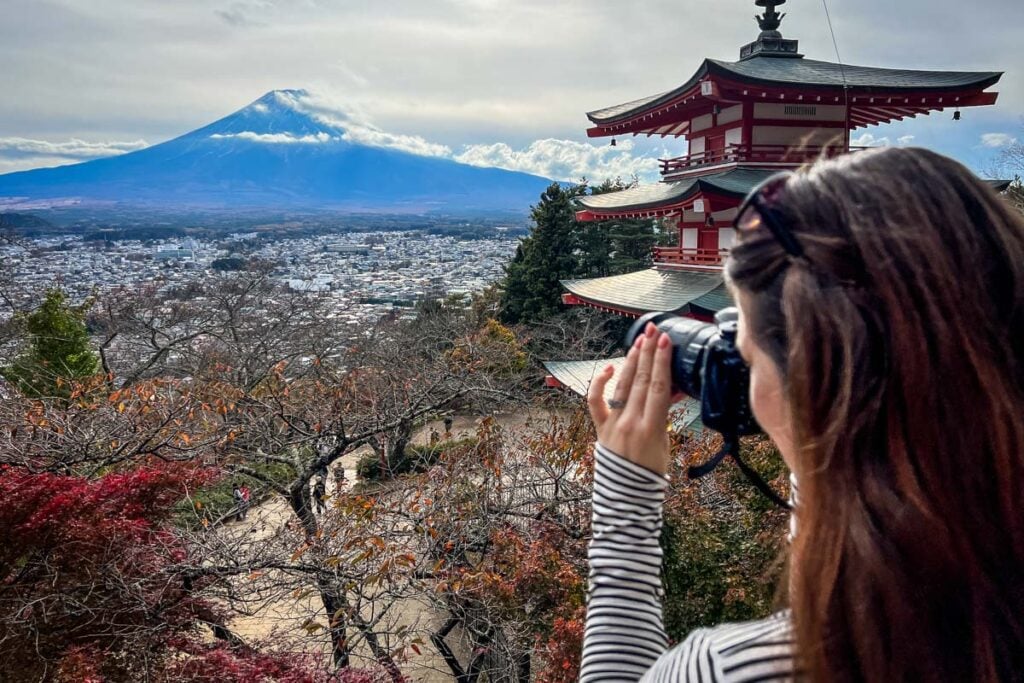
The answer to this question is going to vary greatly on your travel style. It will also depend a bit on the current exchange rate, as this will have a huge impact on your overall costs.
Below, we’re sharing average daily costs (in USD) for different travel styles.
Budget traveler: $100-$145 USD per person, per day
- stay in hostels and basic inns
- stick mostly to free activities
- eat lots of meals from 7-Eleven or inexpensive shops
Mid-range traveler: $200-$290 USD per person, per day
- some splurging and some budget food
- some tours, but free activities too
- watching your spending, but not too closely
Luxury traveler: $500+ USD per person, per day
- stay exclusively at upscale hotels
- lots of tours
- indulge in Michelin-rated restaurants and kaiseki meals
- lots of souvenir shopping
To figure out which category you’ll fit into, start by asking yourself the following questions:
- What type of accommodation do you expect? Do you plan on staying at posh hotels, like the famous Park Hyatt in Tokyo where rooms start at upwards of $700 per night (yes, from the movie “Lost in Translation”)? What about a traditional Japanese ryokan stay? Or are you cool with a $50 dorm bed?
- How important is food to your trip? Do you want to experience highly-acclaimed Japanese dining? Or are you more of a convenience store and street food type of traveler? Do you drink coffee and tea? What about alcohol?
- What about tours and entry fees? Are you planning to go to Universal Studios or Disney? Do you want to take tours and do all the bucket list experiences? Do you prefer arranging activities on your own and sticking to free things to do?
Average daily travel costs in Japan
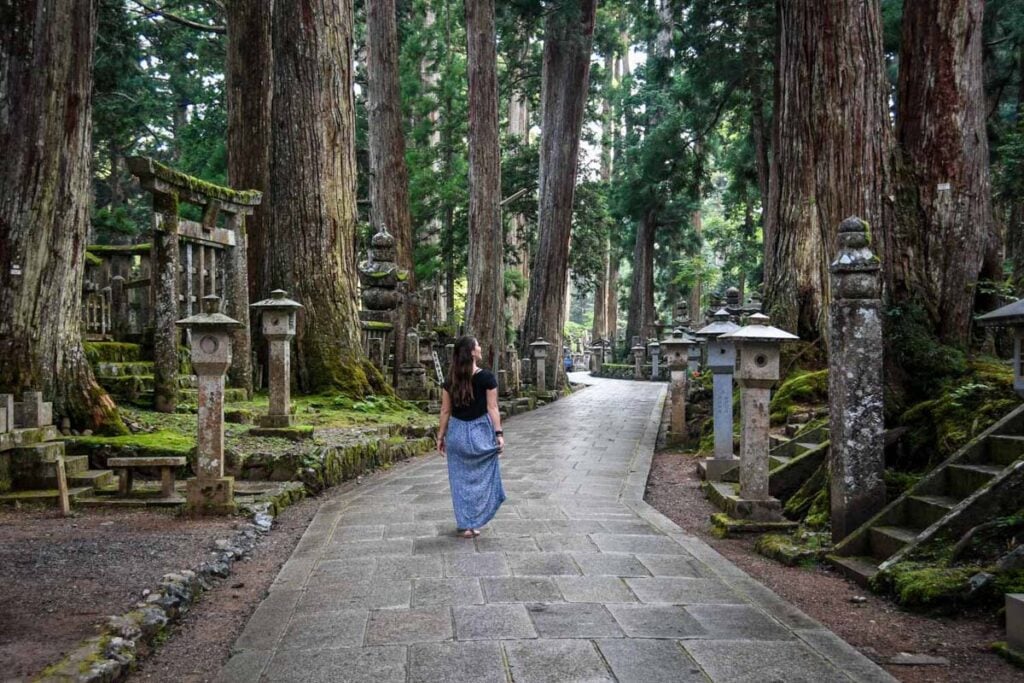
Let’s dive into these numbers! Keep in mind that what you are about to see are average costs. You can certainly save money in some categories, but this should give you something to start with.
Use the samples below to help calculate your own personal Japan travel budget.
Click on each category to see a more detailed breakdown, plus some handy money-saving tips that’ll keep your costs down!
- Accommodation: $150 – $250 per night total*
- This is a mixture of some budget accommodation, as well as splurging on 1 or 2 special ryokan stays Keep in mind that if you are traveling during peak season (like “Golden Week”), your accommodation prices will be on the higher end.
- *Note: Accommodation is based on 2 people sharing a room. If you are a solo traveler and plan to stay in a combination of private rooms and dorms or capsules, this cost may be closer to $45 – $75 USD per night (or a bit higher if you don’t plan to do dorms).
- Transportation: $55 per person, per day
- Based on an itinerary where you visit a handful of cities around the country via train & take public transportation
- Food: $35 – $55 per person, per day
- Based on a combination of budget-friendly meals and splurges
- Entertainment: $15 – $30 per person, per day
- Based on doing a couple of tours and visiting low-expense places, like temples, shrines, gardens, castles, and parks.
- Miscellaneous: $2 – $20+ per day
Total Japan travel budget
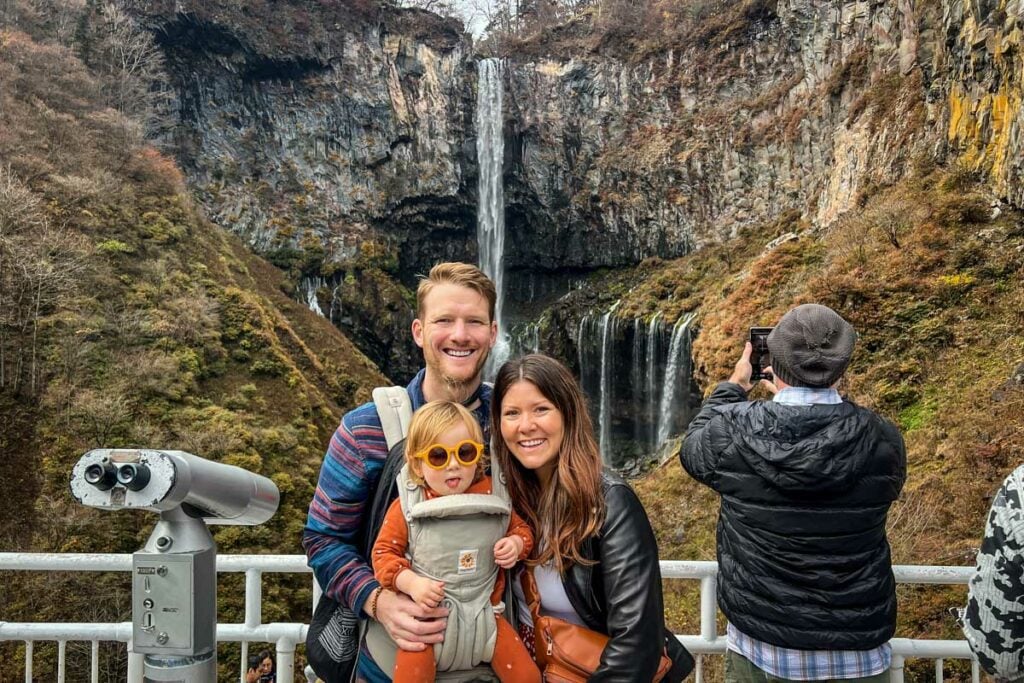
Here are some example numbers to help set your own Japan travel budget based on your personal travel style:
- I am very budget-conscious: $115 USD per person, per day
- I am mindful about my budget, but not super strict and plan to do some splurging: $290 USD per person, per day
- Or, you might find yourself somewhere in between: $220 USD per person, per day
Good to know: The budget estimates above are only for your expenses once you land in Japan. This does not include your international flight getting there, as everyone comes from different places in the world, and travels at different times, so flight prices can vary drastically. We have some tips for finding cheap flights to Japan at the bottom of this article!
Wondering how many days in Japan is enough? Our guide to how many days to spend in Japan will help you figure out how much time you need based on what you want to do.
Yen to dollar
The exchange rate of the yen to the dollar (or your home currency) fluctuates, just like any currency. Currently (November 2024), the yen is quite weak, meaning travelers from some countries (USA, Europe, UK, Australia, etc.) will experience a good conversion rate, making the overall trip less expensive.
We will do our best to keep this article up-to-date, but it’s a good idea to look into the current rates and strength of the yen compared to your home currency as it can truly have an impact on your overall budget.
Our personal experience: When we first traveled to Japan in 2015, the yen was strong, making everything more expensive for us. On our most recent trip (fall 2023), the yen was weak, making things more affordable overall and allowing us to splurge more.
Accommodation costs in Japan
- Average daily cost: $150 – $250 per night total
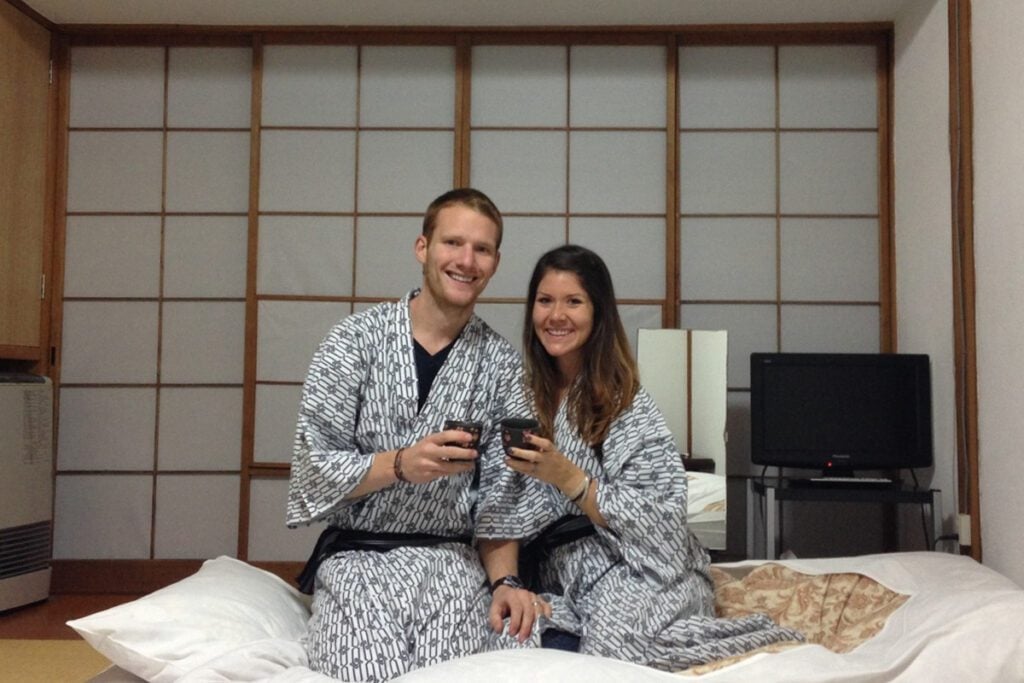
Booking accommodation in Japan can elicit both responses:
- “Holy s***, that’s SO EXPENSIVE!”
- “Ah okay, that’s actually not so bad.”
Let me put it this way: You’re not going to find jaw-dropping hotel rooms for $40 USD like you can in other Asian countries, like Thailand and Indonesia. But there are some reasonable places out there, especially outside of the major cities.
That said, accommodation expenses will comprise a large portion of your entire Japan travel budget, so be mindful of this as you choose your hotels.
Expensive accommodation:
- Tokyo hotels that are well-located
- Ryokan stays (expensive but typically includes meals and is a totally splurge-worthy experience)
- Specialty accommodation, like an onsen resort
- Accommodation near major sites, like Mount Fuji or Kyoto, during peak season (like “Golden Week”)
- Higher-end hotels in Kyoto
Cheap accommodations:
- Capsule hotels or dorm beds
- Accommodation in the countryside (outside of the major cities)
- Simple inns, often with shared bathrooms
Actual Japan hotel costs
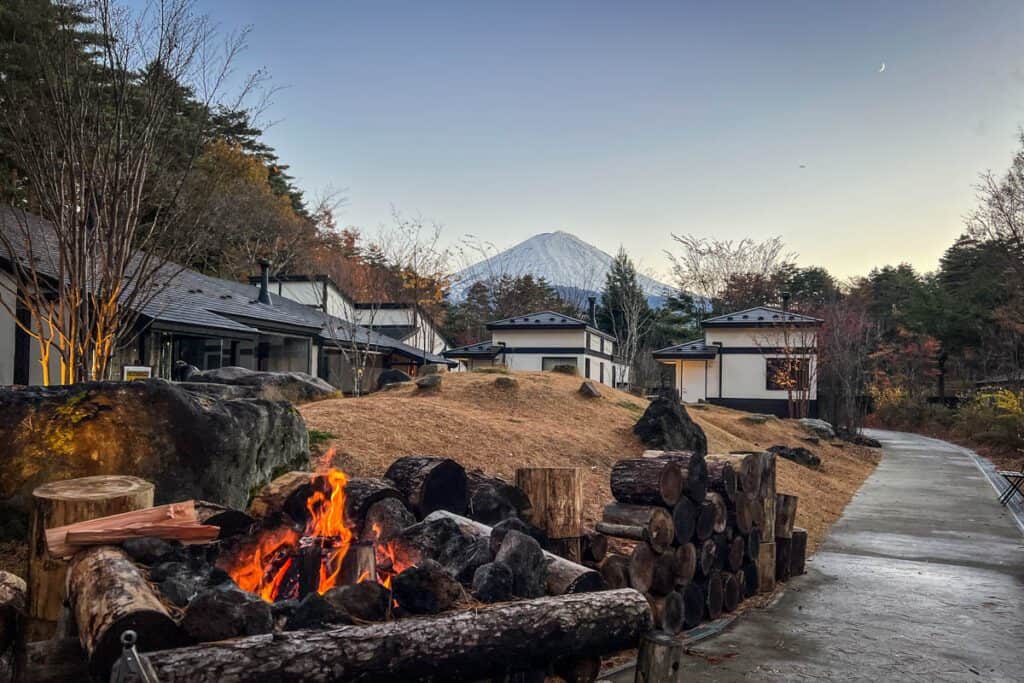
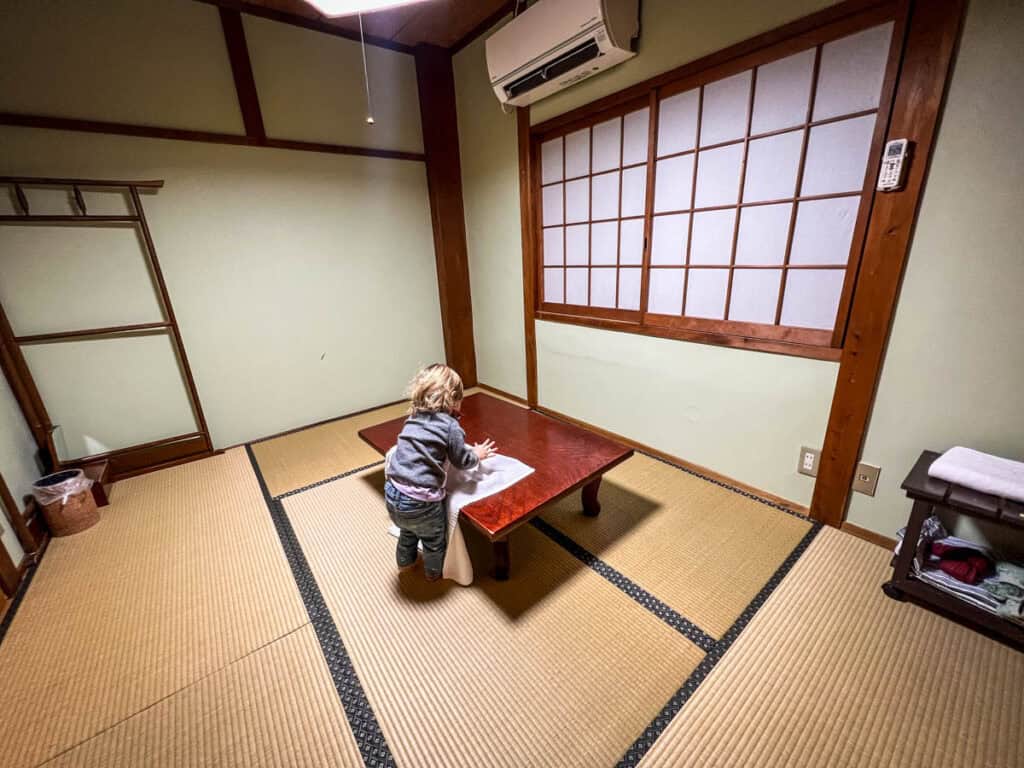
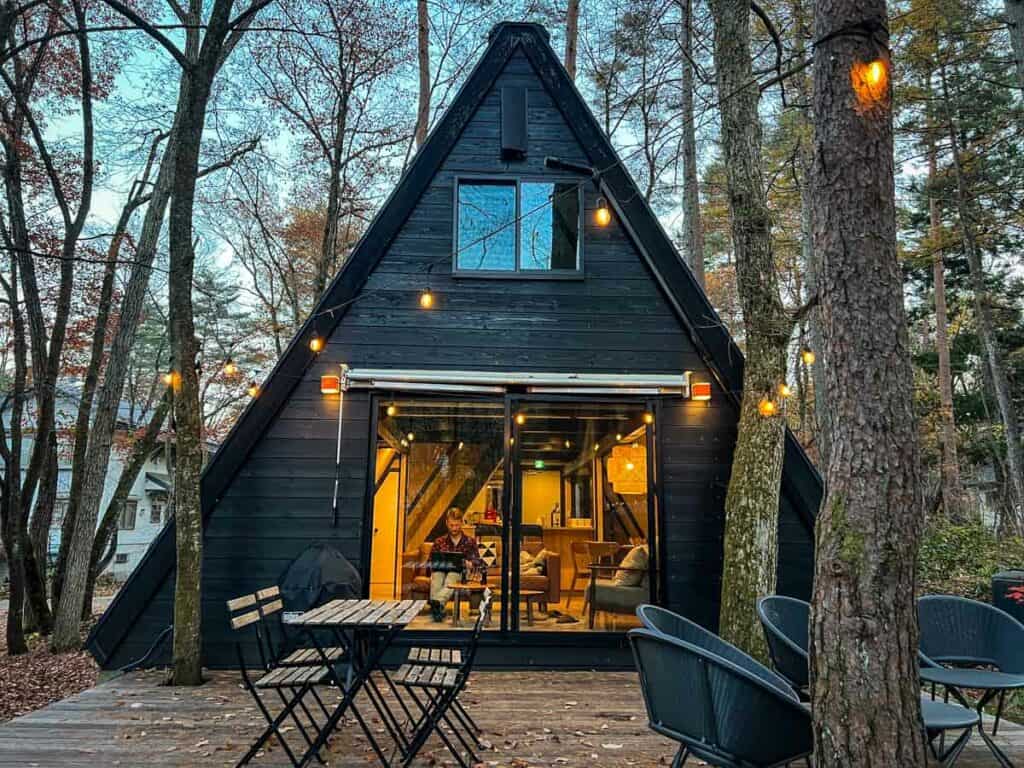
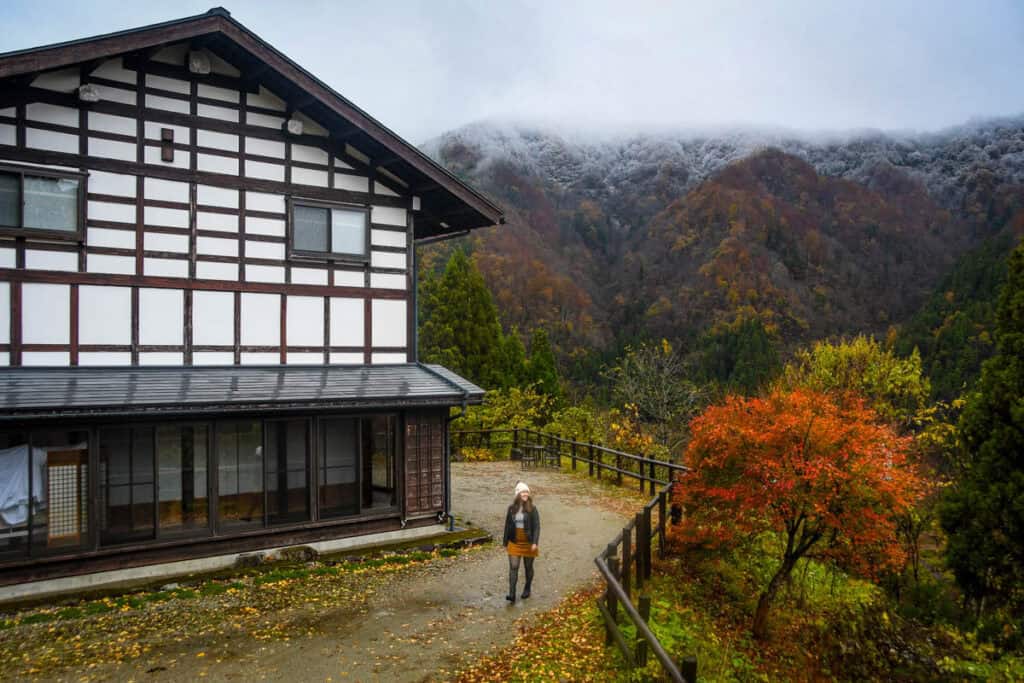
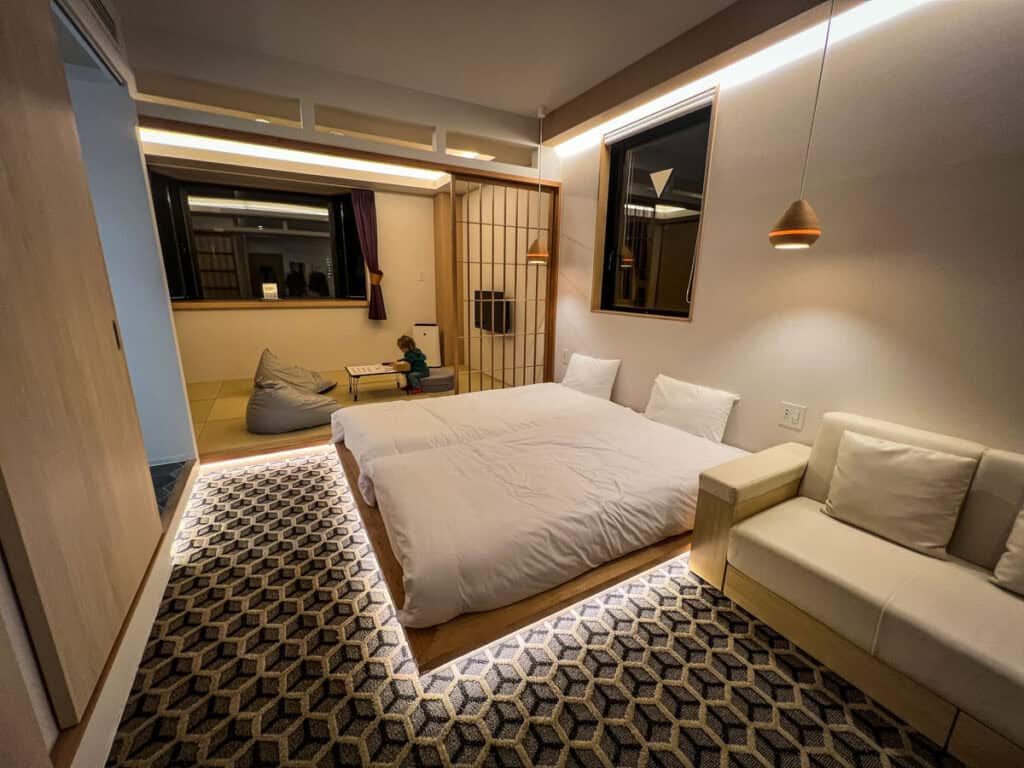
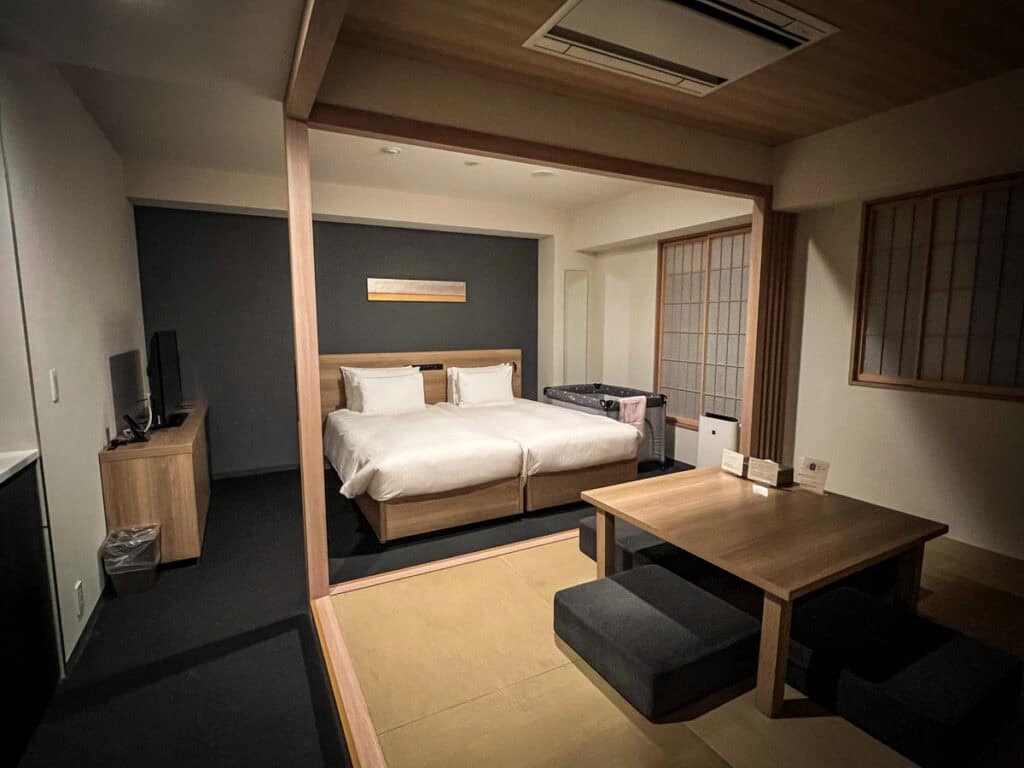
These are actual per night prices we have personally paid for accommodation in Japan:
- $30 capsule hotel in Osaka (note that is $30 for each of us, so $60 total)
- $32 bed in a dorm in Toyama (note that is $32 for each of us, so $64 total)
- $75 private room in a hostel in Matsumoto with shared bathroom
- $100 room in a lovely guesthouse in Takayama with a shared bathroom
- $105 tiny hotel room outside of Tokyo city center
- $114 simple room with shared bathroom on the Nakasendo Trail (including wonderful dinner & breakfast) – we stayed here twice
- $214 tiny but well-located hotel room in Shibuya
- $213 onsen lodge in Nikko National Park (including amazing breakfast)
- $226 temple stay at Koyasan, which included an incredible dinner and breakfast
- $250 wonderful hotel in Kyoto
- $290 glamping stay near Mount Fuji during peak leaf peeping season
- $324 huge hotel room a bit outside the city center in Tokyo
As you can see, there is quite a bit of variance. We’ve paid anywhere from $60 to $324 per night while in Japan.
Tokyo accommodation: Sample prices
Being that Tokyo is incredibly dense and space is scarce, prices are high for what you get. Your Tokyo hotel will likely be some of the most expensive on your trip.
Here are some examples of what you can expect when it comes to cost of a hotel room in Tokyo.
- Budget: ¥8,600 for a dorm bed in a cheap hostel (around $60 USD)
- Mid-range: ¥22,000 – 38,000 for a private room in a guesthouse or cheap hotel (around $120 – $250 USD); Note: the cost will vary a lot depending on the location and the time of year
- High-end: ¥65,000+ for a Western style hotel or ryokan (around $440 USD and up)
Tips for saving money on accommodation in Japan
Accommodation is arguably going to be one of your biggest expenses when traveling in Japan. Below are some tips that will save you money on accommodation in Japan.
- Look specifically for budget accommodations
- Know some tricks when booking your hotel
- Stay for free (if your schedule is flexible)
1. Look for budget accommodations
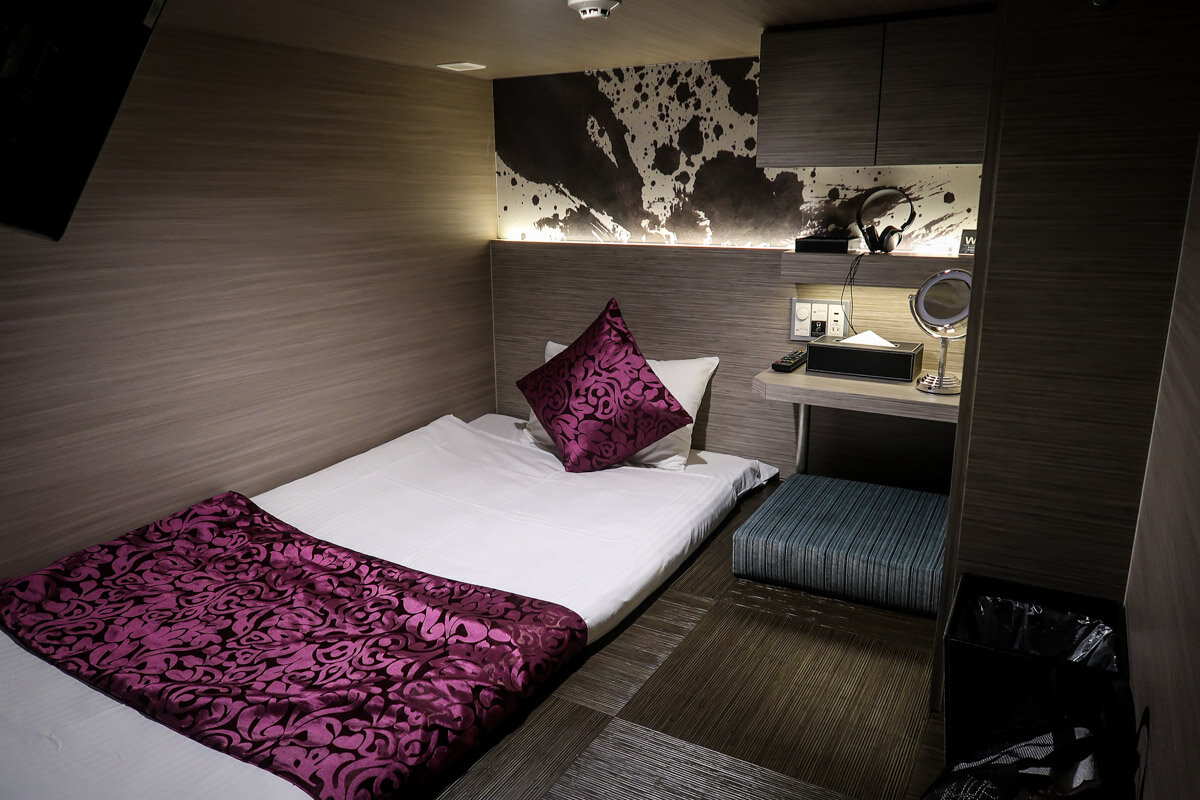
The following types of accommodation are good options for those on a tight budget:
- Hostels: No matter where you’re traveling, hostels are the most affordable option, and Japan is no different. The hostels we’ve stayed at in Japan tend to have large dorm rooms instead of small dorms or private rooms.
- That said, they had a pretty high standard of cleanliness and each dorm bed had privacy curtains. One thing to note is that we found hostels in Japan to be less friendly/communal than most other places in the world. That could have just been our personal experience though.
- Capsule hotels: These pods are similar to dorms in a way, but each capsule is larger and more roomy than a dorm bed. There are also usually some additional amenities like public baths and pajamas, which hostels don’t offer. Nicer capsule hotels can get to be a bit expensive in Japan, but you can find very basic ones as well.
- Staying in a capsule hotel is just one of those “Japanese experiences” you should have at least once on your trip!
- Airbnb: It’s a good idea to check Airbnb to see if there are any listings that fit your budget, as they can be more affordable than traditional hotels. We don’t necessarily recommend Airbnbs in big cities, like Tokyo, Osaka, and Kyoto. But they can be a good option if you’re traveling in smaller towns or in the countryside.
2. Book your hotel like a pro
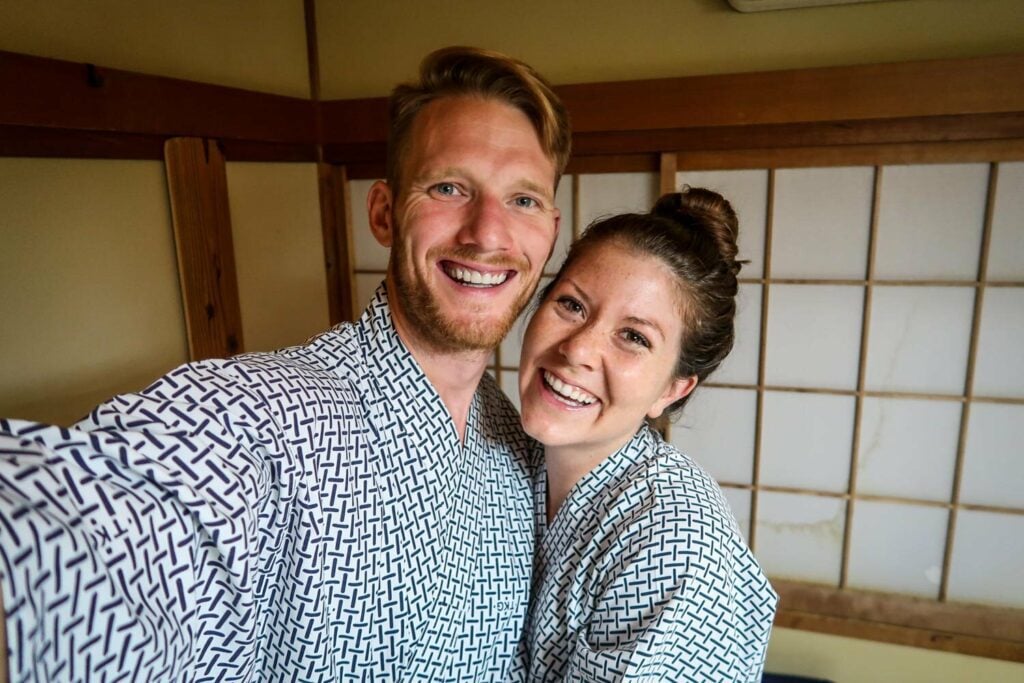
Here are a couple of tips that will help you when booking hotels in Japan:
- Book early, if possible. The good hotels that are reasonably priced get snagged quickly (especially during popular tourist seasons).
- When possible choose hotels with free cancellation. Booking.com often offers this up until a few days before your arrival. This can make it easier to secure a great price when you see it because there isn’t a risk of losing money if you change your plans.
- When booking, we like to use all the filters to our advantage. With Booking.com for example, there are tons of different options to click on the left side of the page. That way in a city with tons of options, like Tokyo or Osaka, you can narrow it down to a hotel that is perfectly suited to you. Select your budget, preferred neighborhood, guest rating, type of room, breakfast preference, etc.
3. Consider Couchsurfing, House Sitting or WorkAway
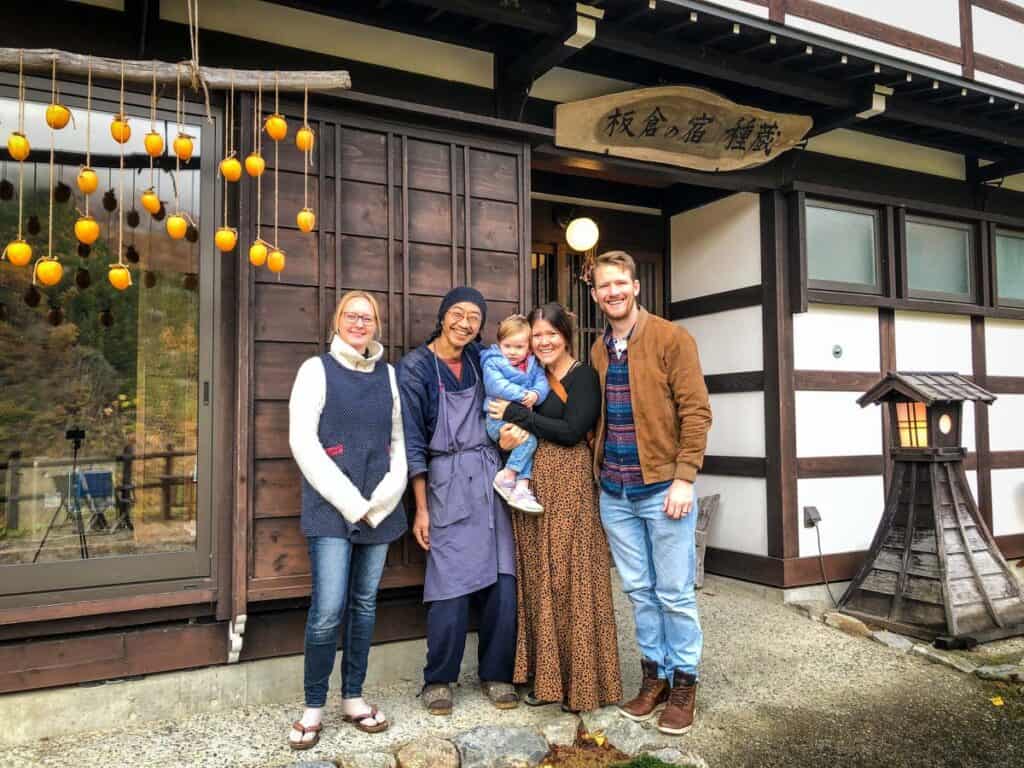
If you’re on a super tight budget and have some flexibility in your timing (lucky you!), you might want to consider Couchsurfing or WorkAway opportunities.
- Couchsurfing: Stay in a local’s home for free! Couchsurfing is more than just a free place to crash; it’s an opportunity to connect with a local and see their home country through their eyes. Oftentimes accommodation on Couchsurfing will be outside the city center so be sure you know how you’ll get around. Also, many hosts require guests to stay a certain number of days so they don’t get people only interested in a free bed.
- House sitting: Truthfully, there aren’t a ton of house sitting options in Japan, however, it’s worth a shot if you have flexible dates.
- WorkAway: Volunteer your time in exchange for room and board. Many places require that you stay at least a week (or sometimes even two!), so you’ll need to have a flexible schedule. This can be a great way to see a different side of Japan than you’d see otherwise. Just be sure to read reviews before you make a commitment. Here are some opportunities that look pretty cool:
Transportation costs in Japan
- Average daily cost: $55 per person
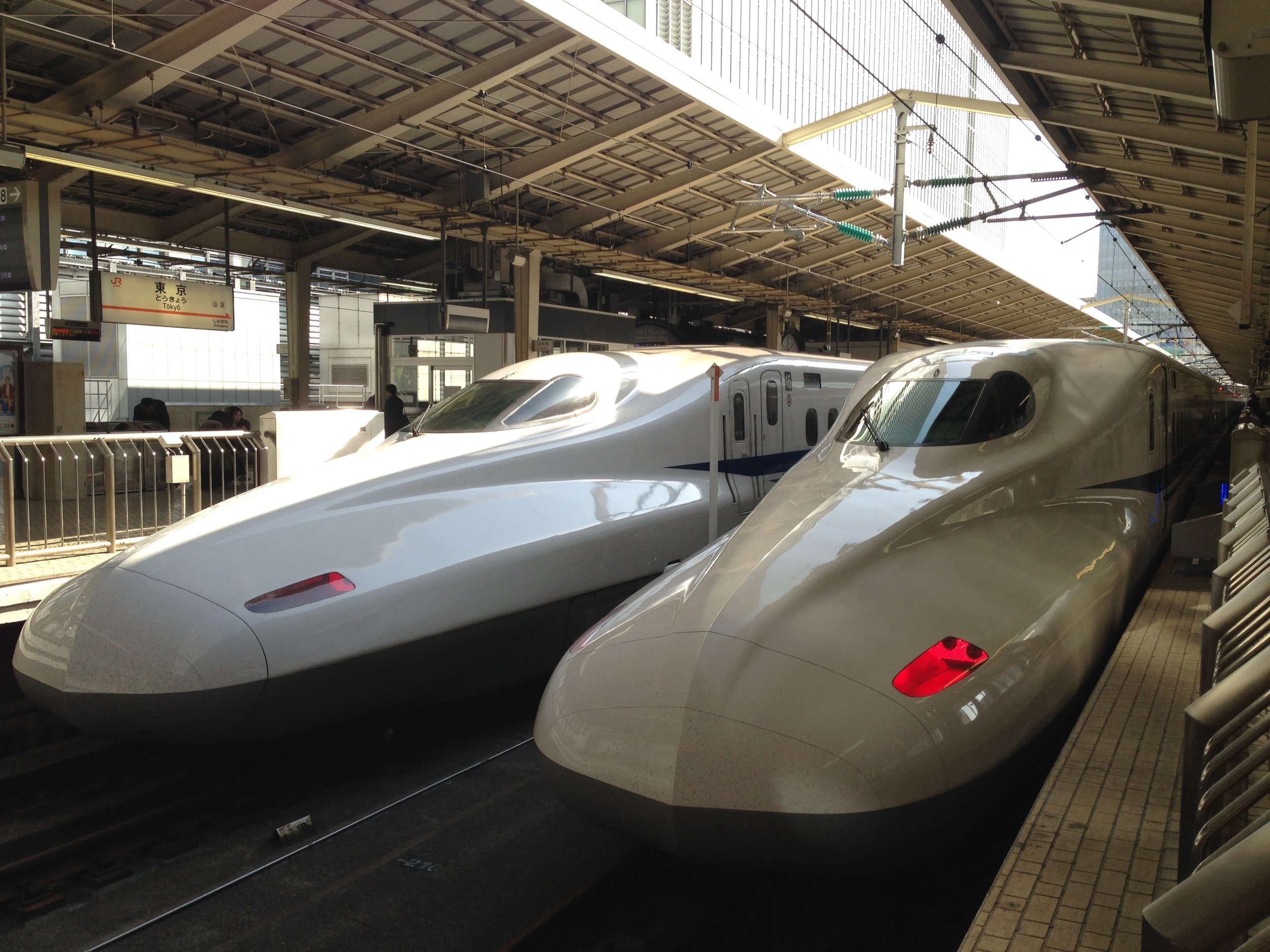
Japan is a relatively small country, but it is packed with so many beautiful places to see that it can be downright overwhelming.
The good news is that this country is very well connected by trains, roads, subway systems, and airports. There are many different options when it comes to transportation in Japan.
Depending on your itinerary, you’ll have to do a bit of research and calculations to determine the best option for you.
Trains
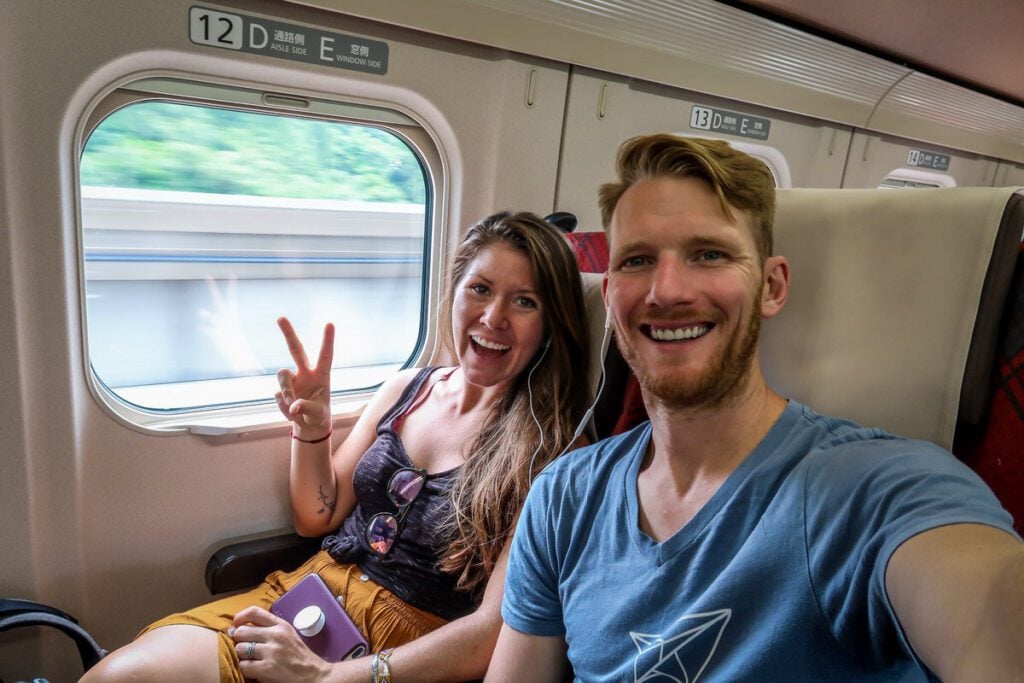
Japan is famous for its efficient, fast, and clean Shinkansen, or bullet trains.
The Japan Rail Pass is a package that foreign travelers can purchase which gives them access to certain trains without having to pay for each individual ticket.
→ This JR Pass guide walks you through how to figure out if it will save you money.

Here are the current prices of the Japan Rail Pass:
- 7-day Pass: ¥50,000
- ~$340 USD, or ~$50 USD per day
- 14-day Pass: ¥80,000
- ~$550 USD, or ~$40 USD per day
- 21-day Pass: ¥100,000
- ~$690 USD, or ~$33 USD per day
Renting a car

There’s also the opportunity to rent a car in Japan. If you want to get off the beaten track and visit some lesser-known areas in the countryside (highly recommend this!), renting a car can be really fun and it can actually save quite a bit of money.
We rented a car for 15 days in Japan and paid a total of $822 for two adults and a baby.
On top of the rental price, we got insurance (which was covered by our credit card), toll fees (totaled about $125 USD), and gas/petrol (about $150 USD).
Our overall cost for renting a car in Japan for 15-days came to $1,097 USD, roughly $73 USD per day for our family of three.
Domestic flight
Taking domestic flights within Japan could be an option. Prices vary based on the airline as well as the time of year and how far in advance you’re searching.
- Tokyo to Sapporo flight (one-way): $35 – $85
- Tokyo to Osaka flight (one-way): $32 – $97
- Tokyo to Okinawa flight (one-way): $75 – $190
Good to know: When comparing flights to trains, be sure to account for the cost of transportation getting to and from the airport, as this can add quite a bit. Factor in the time needed to get to the airport and through security as well, because it will sometimes take at least as long as the train, if not longer.
Metros and buses
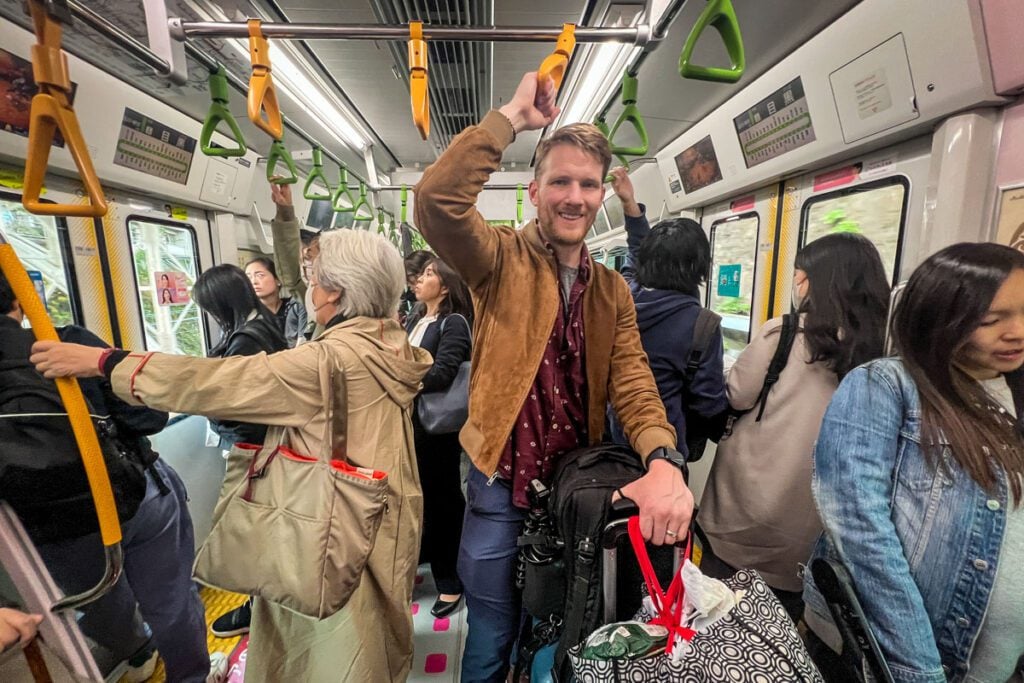
Large cities have subway systems and buses. We highly recommend loading a Suica, Pasmo, or ICOCA virtual card to your phone’s wallet before your trip.
The prices will vary depending on the city you’re in and how far you travel. Each ride ranges around ¥140 – ¥314 ($0.93 – $2).
Our personal experience: On our most recent trip, we spent around ¥4,000 ($27) each during our entire trip for subways and buses around Japan.
Some cities also have passes where you can ride unlimited times, so you may want to look into whether or not that would make sense for you.
Tokyo Subway Pass
- 24-hour ticket: ¥800 adult / ¥400 child
- 48-hour ticket: ¥1,200 adult / ¥600 child
- 72-hour ticket: ¥1,500 adult / ¥750 child
Tips for saving money on transportation in Japan
There are some really great money-saving options for transportation in Japan if you know what you’re looking for. We’re going over a handful of different options that will save you money on transportation in Japan:
- Potentially get the Japan Rail Pass
- Compare trains to renting a car or taking a domestic flight
- Look into regional tourist passes
- Consider city transport passes
1. Get the Japan Rail Pass (maybe…)
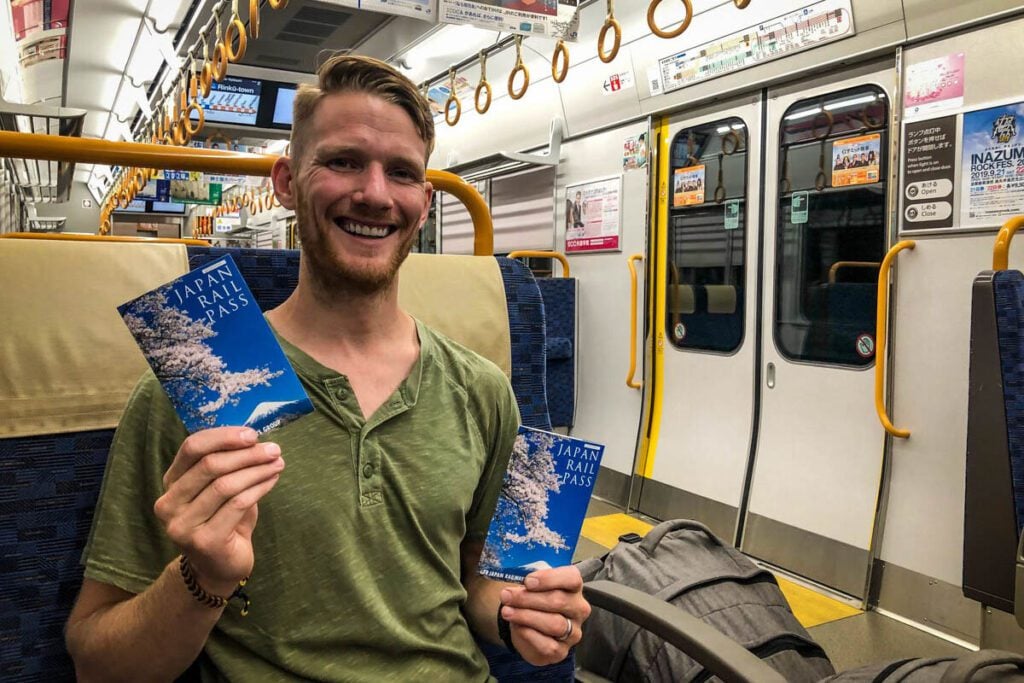
It is a train pass only available to foreign tourists in Japan. It allows you to ride specific trains for one bundled price instead of paying for each ticket.
Is the JR Pass worth the money?
This is a tricky question to answer… In the past, I would have said 100% YES. It was a huge cost savings.
However, there was a pretty major price increase to this super discounted pass in late 2023. This means that it won’t be as big of a cost savings as it used to be.
Depending on your itinerary, it may not even make sense to purchase the JRail Pass… Alternatively, it could still save you money. You’ll need to do some calculations to figure out if it makes sense.
Don’t worry – we’ve gotchu!
We put together a guide that walks you through how to decide if this pass is a good purchase for your trip or not.
We don’t want you to spend unnecessary money, so be sure you read this thoroughly in order to make the best decision for you.
2. Compare trains with other modes of transportation
Depending on your itinerary, it might actually make more financial sense to rent a car or to take a domestic flight.
Due to the price increase on train tickets, these other modes of transportation can actually be cheaper, depending on where you’re going.
→ Psst! We’ve got an entire guide to renting a car in Japan (we did a 15-day car rental and absolutely loved it!). Our guide breaks down all the costs involved with renting a car and goes over some essential driving tips.
3. Look into regional tourist transportation passes
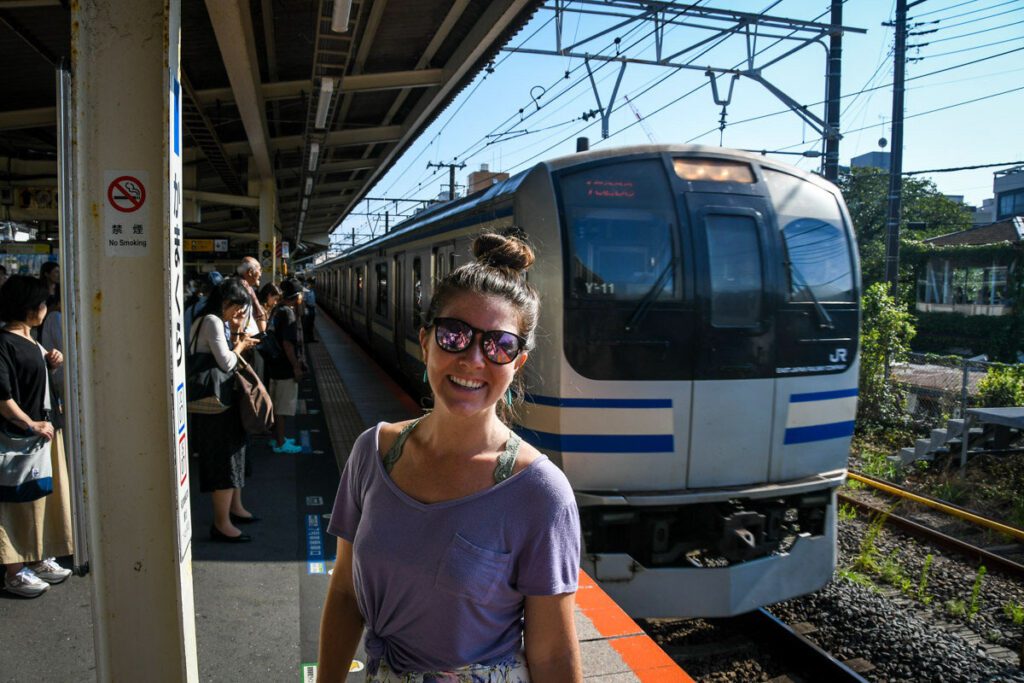
Many places in Japan are not connected with JR lines or metro systems. Instead, there are sometimes regional tourist passes available.
This will be a “bundle” pass which generally includes different modes of transportation, like rides on regional buses, cable cars or a funicular.
If you’re traveling outside of major cities in Japan (and you should!) check to see if that region has a tourist pass.
Here two examples of bundles that can potentially save you money:
- Hakone: This small mountain town known for onsen and views of Mount Fuji can be reached by JR trains, but once you’re there, getting around the area is not covered. Instead, most tourists buy the Hakone FreePass, which includes all bus, boat, and cable car transportation in the area.
- Koyasan: This area known for Buddhist temple stays and stunning Okunoin Cemetery cannot be accessed with JR trains. The Koyasan World Heritage Ticket is what most visitors use for this area.
4. Consider city passes
In major cities, like Tokyo, Kyoto, and Osaka, it might make sense to get a public transportation pass so that you can ride the subway and bus systems as much as you’d like.
It really depends on how much exploring you’ll be doing, so do a bit of calculating to see if it makes sense for your trip.
Food & drink costs in Japan
- Average daily cost: $35 – $55 per person
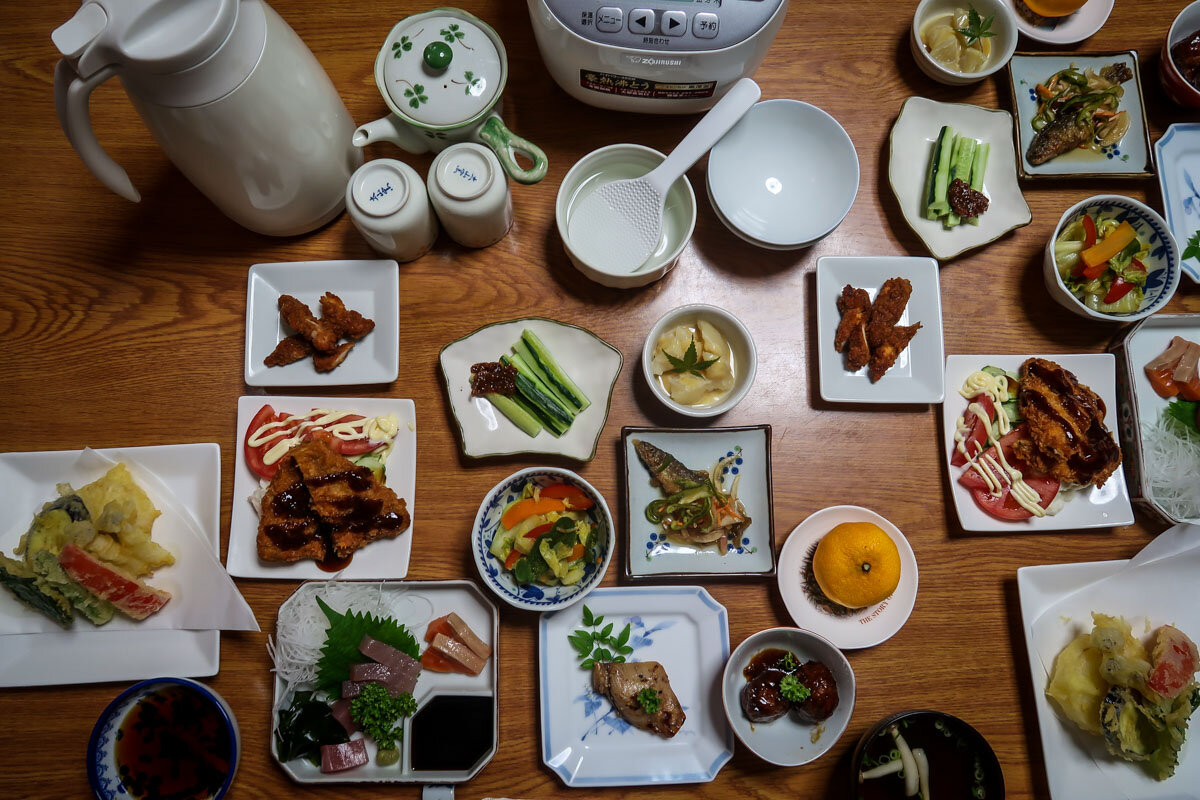
Food is a funny category because it can simultaneously bust or save your budget.
Eating out at a typical restaurant can add up incredibly quickly. And high-end restaurants can come with eye watering bills.
But at the same time, you can get an entire meal at a convenience store (much less sketchy than it sounds) for just a few bucks or Michelin-rated street food for not much more than you’d expect to pay at a fast food restaurant.
Our advice is to have a happy combination of both splurge-worthy meals and cheap eats to balance things out without sacrificing your experience.
Expensive meals:
- Any type of traditional kanseki restaurant
- High-end sushi
- Waygu or Kobe beef
- Theme restaurants
Cheap meals:
- Bento boxes
- Konbini (convenience store) meals
- Conveyor belt sushi
- Ramen, udon, or soba
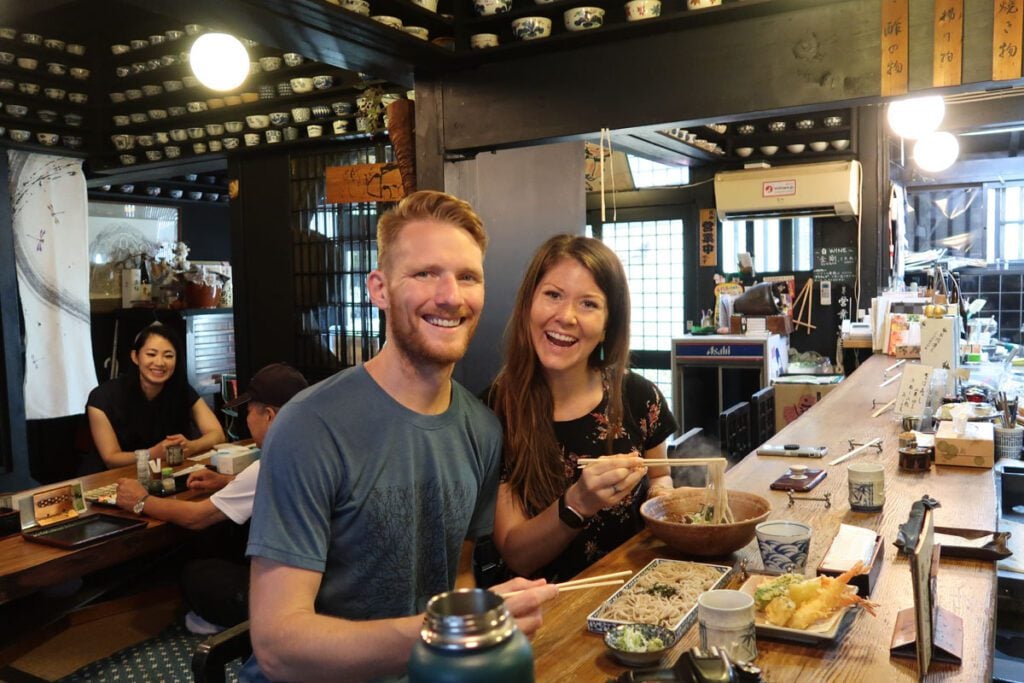
Meal prices in Japan:
This is a breakdown of how much we would personally allocate to our daily food budget:
- Breakfast: $5 – $7
- Lunch: $10 – $15
- Dinner: $15 – $25
- Snacks: $5 – $8
This works out to be $35 – $55 per person, per day for meals and snacks. This will allow you to try just about any food you desire and will leave room for splurge meals.
Our personal experience: Some days we would splurge on dinner and spend $60 each, but have a small snack for lunch. On other days both lunch and dinner were under $15. It all kind of evens out in the end, but these are some numbers to help you get started.
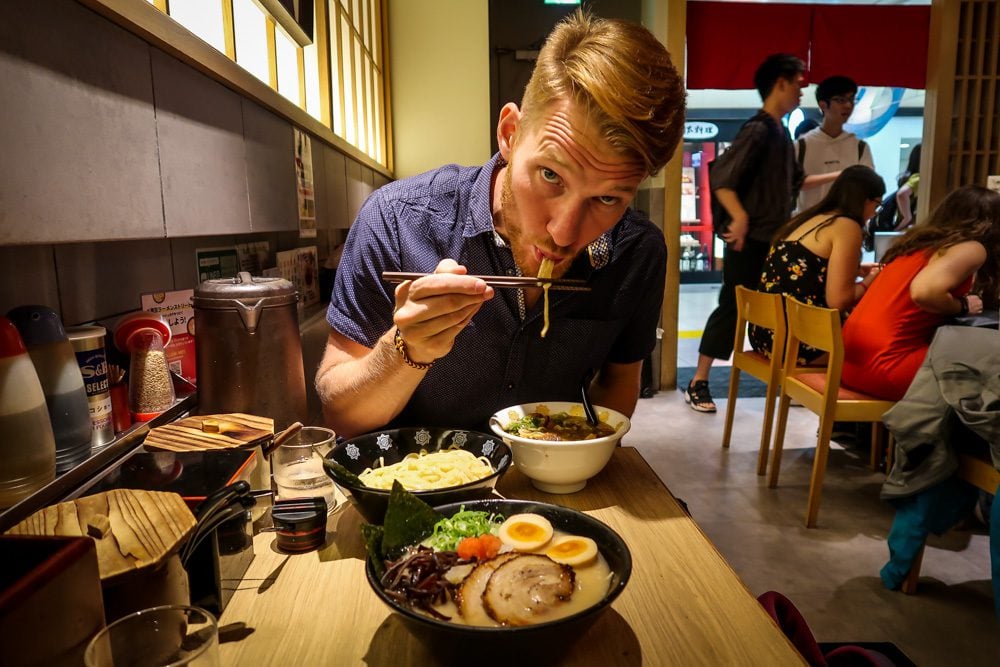
If you’re a big foodie and can’t wait to get your hands—errrr, tongue—on ALL the Japanese food, you may want to increase this section of the budget because $25 for dinner is still going to restrict what types of restaurants you can eat at.
However, if you’re not big on eating out and are totally cool with getting most of your food from convenience stores or budget restaurants, you could lower this to $30 per day.
In fact, during our first trip to Japan (back in 2015), we averaged just under $14 per person each day for all meals and snacks. But there were a lot of foods we didn’t have the chance to try because of our restrictive budget, so we wouldn’t recommend aiming for this.
→ Psst! You definitely want to check out this article with all the best Japanese foods to be sure you try during your trip!
Bonus: Snacks, treats, coffee, tea & alcohol
Don’t forget all the extras!
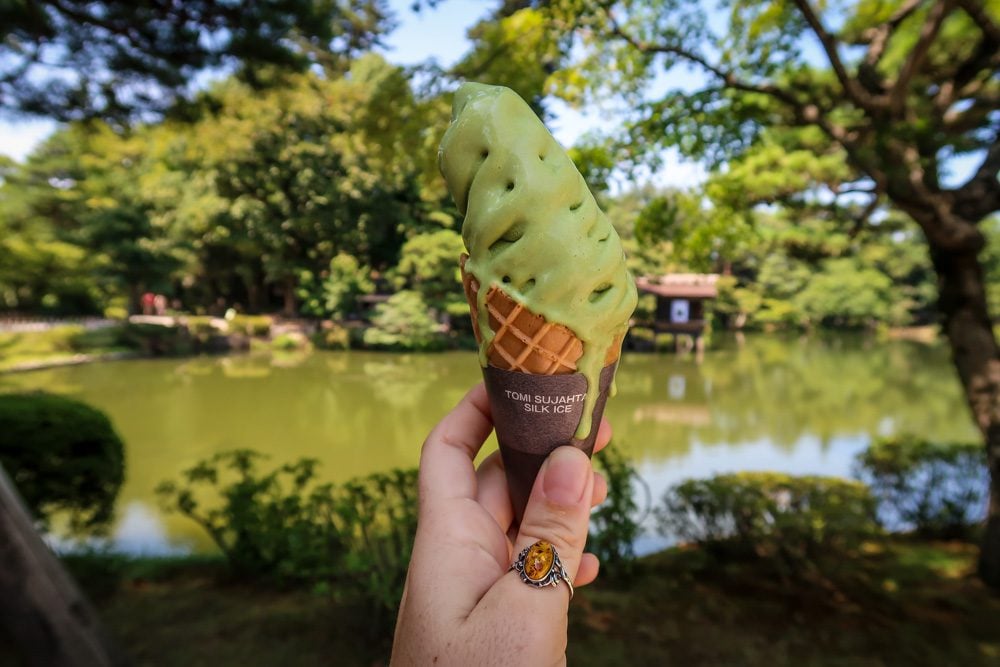
This category will vary greatly from person to person based on your travel style and priorities.
If you drink alcohol, coffee, matcha, treats, or snacks, here are some average prices to know:
- Sake at a restaurant: ¥500 – ¥700 ($3.30 – $4.60)
- Bottle of nice(ish) sake: ¥1,800 ($12)
- Cocktail at a speakeasy: ¥2,000 ($13)
- Coffee: ¥500 ($3.30)
- Matcha: ¥500 ($3.30)
- Ice cream cone: ¥300 ($2)
- One piece of fresh mochi: ¥200 ($1.30)
- Packaged pastry at konbini: ¥200 ($1.30)
Based on these average prices, add as much as you think you’ll need to your daily budget.
Tips for saving money on food in Japan
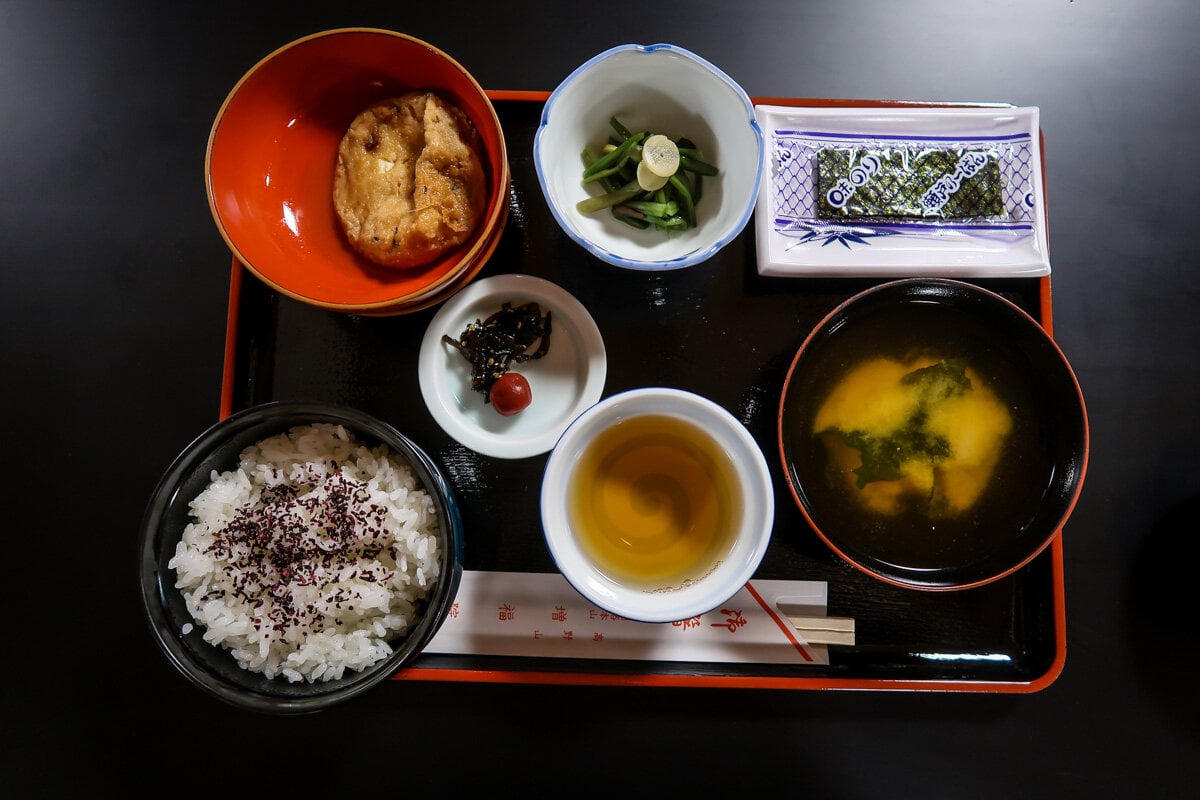
This is one of the areas you can really save on if you are traveling Japan on a budget. We’re going over a handful of different options that will save you money on food in Japan:
- Order “breakfast sets”
- Eat convenience store meals
- Eat your biggest meal at lunch
- Book accommodation with a kitchen
- Get cheap sushi
- Eat less fruit
- Pack snacks from home
- Bring your own coffee maker
1. Order “breakfast sets” from coffee shops
I love breakfast. Give me a smoothie or scrambled eggs and I’m one happy lady. But in Asia, breakfast is just different. Rice and soup are common breakfast items, and there just really aren’t many breakfast restaurants. For that reason, many hotels catering to Western tourists will have an option to add on breakfast, typically for $10 – 15 USD.
If budget is a constraint, skip this and instead, head to a nearby chain coffee shop where “breakfast sets” can be a pretty good deal.
You’ll select a breakfast option, like an egg sandwich, croque monsieur, or a pastry, as well as coffee or tea. Together, the meal and the drink will come to around 400 – 600 yen.
Common coffee shop chains in Japan that offer “morning sets” are Doutor, Caffe Veloce, St. Marc, and Pronto.
Alternative: Another option is to grab something at a convenience store, like a pastry item and iced coffee. (See more below…)
2. Eat meals at convenience stores
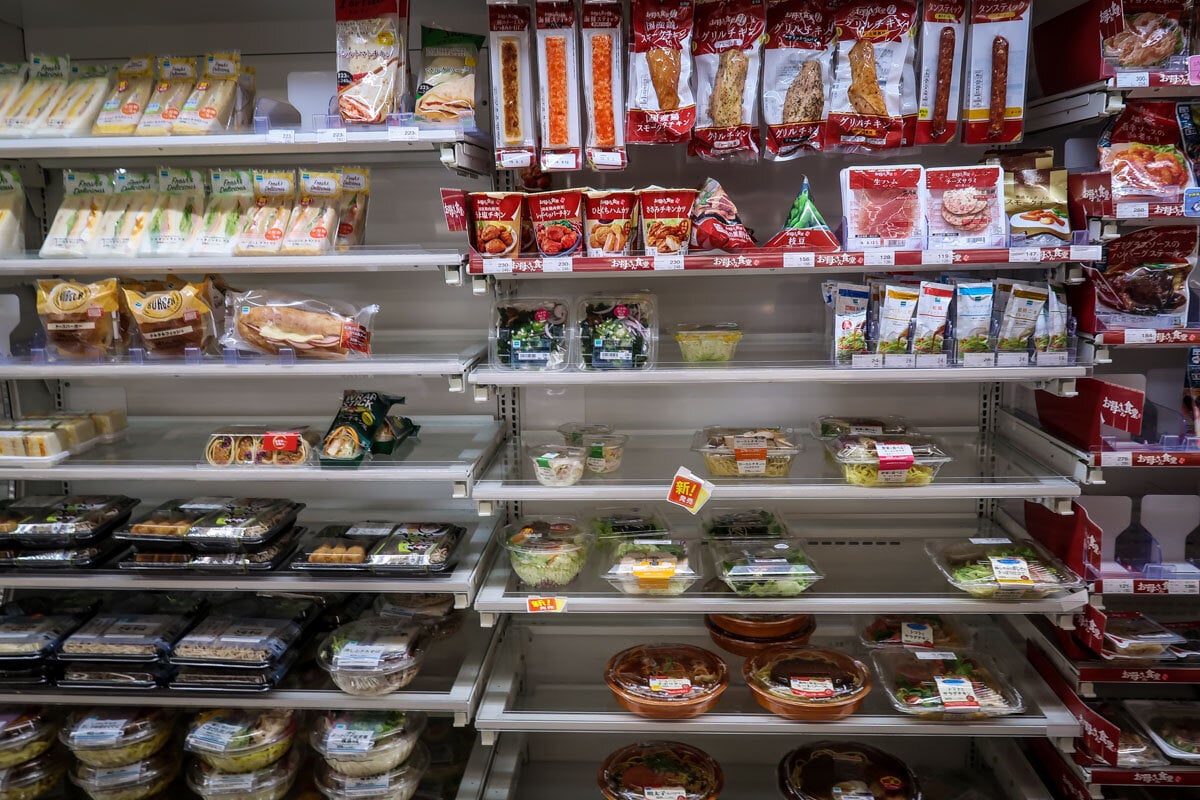
If you’ve been researching Japan, you’ve probably heard a bit about the convenience store culture. You’ll be able to find marts (konbini) on just about every block (sometimes multiple on a block), and entire meal options inside.
Many Japanese businessmen and businesswomen rely on these meals for quick lunches and dinners, and you’ll find options like fresh noodle dishes, dumplings, sushi, rice bowls, meat cutlets, and pasta that can all be heated up by the cashier if needed.
Additionally, you’ll find desserts, pastries, chips, and other snacks, just like any convenience store.
Sometimes I hear travelers talk about how they are only going to eat at 7-Eleven during their trip to Japan to keep costs down; but I think this is a mistake for two reasons:
- Trust me when I say you’ll want something other than super processed foods for every meal. Yes, there are many options at the convenience stores, but finding actually healthy options is challenging, to say the least.
- You’ll want to have some splurge-worthy meals! Unless you’re really not into food, you’ll definitely want to explore Japanese cuisine outside of 7-Eleven. There are so many incredible places to eat in Japan, and it would be a shame to not try any of the cuisine outside of convenience stores.
Moral of the story: Plan to balance your cheap meals with some splurge-worthy ones to have a balanced food budget.
3. Have your biggest meal at lunch
Restaurants in Japan often have “lunch specials” where they serve a similar meal to what you’d get at dinner, but for a cheaper price.
4. Book accommodation with a kitchen
We booked a handful of accommodation options with kitchens, which really helped us keep our food costs down.
Many hostels have kitchens, as do some of the budget-minded guesthouses. Sometimes hostel kitchens are gross and have minimal equipment, but in Japan we found all the kitchens to be really well-stocked and clean!
Expert Tip: Convenience stores usually have a section with frozen vegetables and other meals, which is a good place to look if you want a cheap and easy dinner.
5. Get cheap sushi
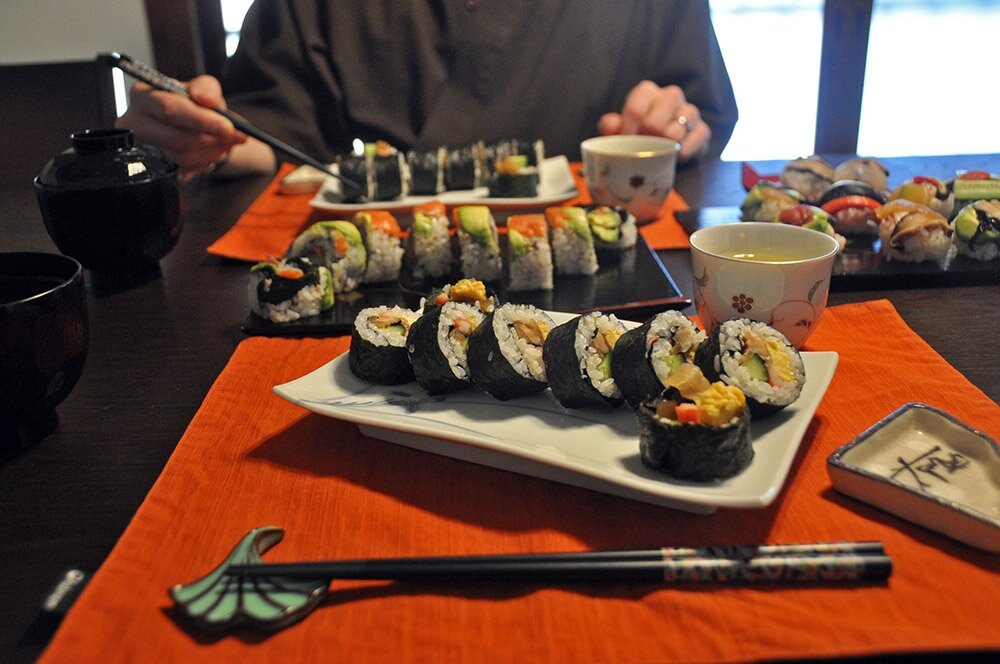
If you’re a sushi-lover, you’re definitely going to want to go to the famous fish markets and order a set at least once. This will set you back a cool $40 USD (if not more!), but it’ll be worth it for some of the freshest fish in the world.
That said, it’s not possible for most of us budget travelers to do this more than a couple of times. So if the sushi craving strikes again during your trip, consider some cheaper alternatives.
Conveyor belt sushi is popular with locals and it allows you to try many different types while keeping the cost down.
Another surprising option is getting sushi at convenience stores. I would never recommend doing this in say, the United States, but in Japan, it’s far less sketchy than it sounds. Japanese people do this all the time, and the quality is actually very good for the price you pay.
6. Eat less fruit
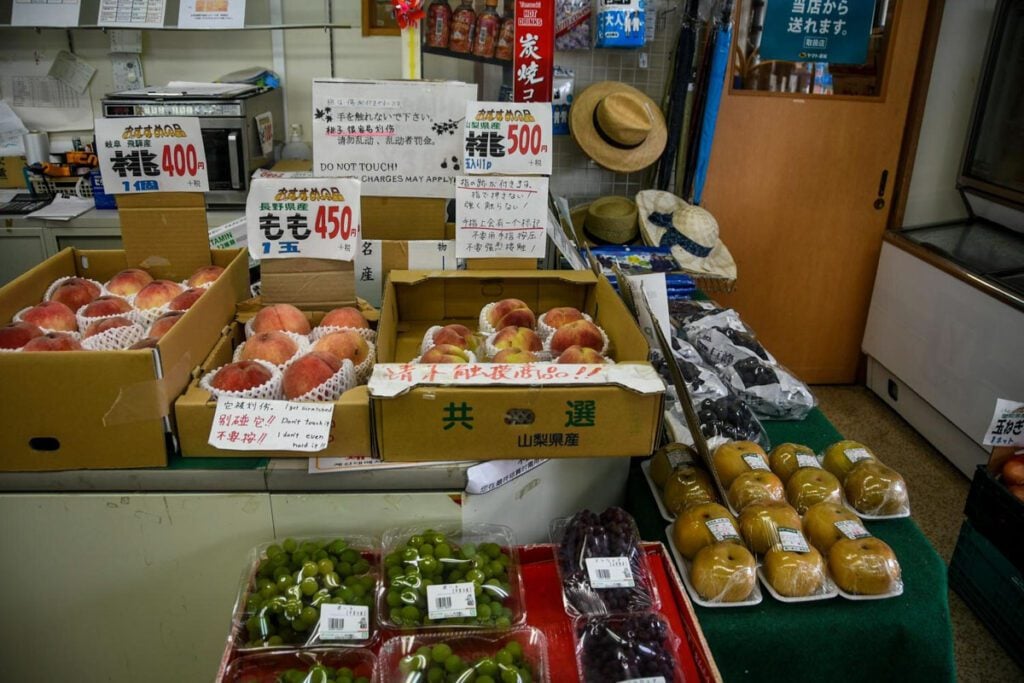
I’m about to drop a bad news bomb: Fruit is generally pretty expensive in Japan.
Think $3 – $4 for a single peach and $1 for a single (plastic-wrapped) banana…
It’s fine every once in a while when the craving strikes, but if fresh fruit is a daily habit, it’s gonna add up.
Interesting Tip: We found that some local fish markets had fruit stands, and the prices were the cheapest we found anywhere. Also, keep your eyes peeled for small roadside stands next to farms. We found a few of these selling fruits and veggies for reasonable prices.
7. Pack your own snacks from home
If you’re flying to Japan from your home country, consider packing some snacks like protein or granola bars, trail mix, and dried fruits.
You can find some of these things in Japan (with a lot of searching), but they tend to be quite expensive or come with added sugar, which we’re not huge fans of.
Having these handy will help keep your snacking costs down, and will help you avoid the “but I’m so hungry I just need something” splurges (we’ve all been there). And most importantly (in my opinion), it’ll keep you feeling healthy during your trip.
8. BYO coffee maker
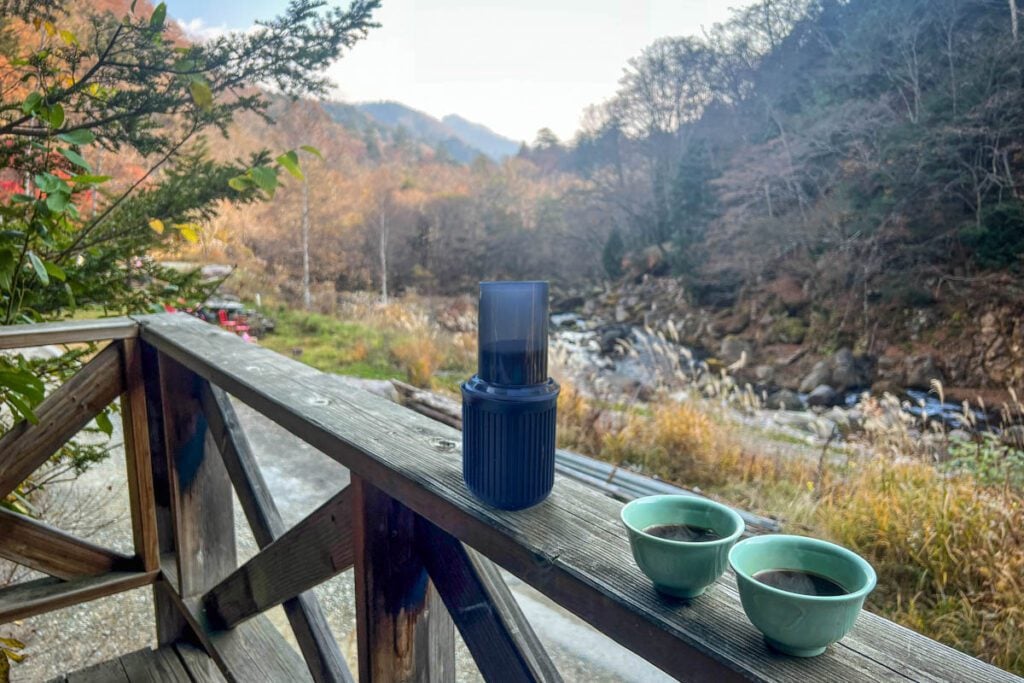
If you love to start your morning with coffee, you may want to consider bringing your own. Most hotels in Japan do not have coffee makers, like you might be used to in other parts of the world.
We packed our travel Aeropress and were so happy we did. We could enjoy our morning coffee without having to seek out a coffee shop (many of which actually open quite late!) and we saved a lot of money by not buying daily Americanos!
Entertainment costs in Japan
- Average daily cost: $15 – $30 per person
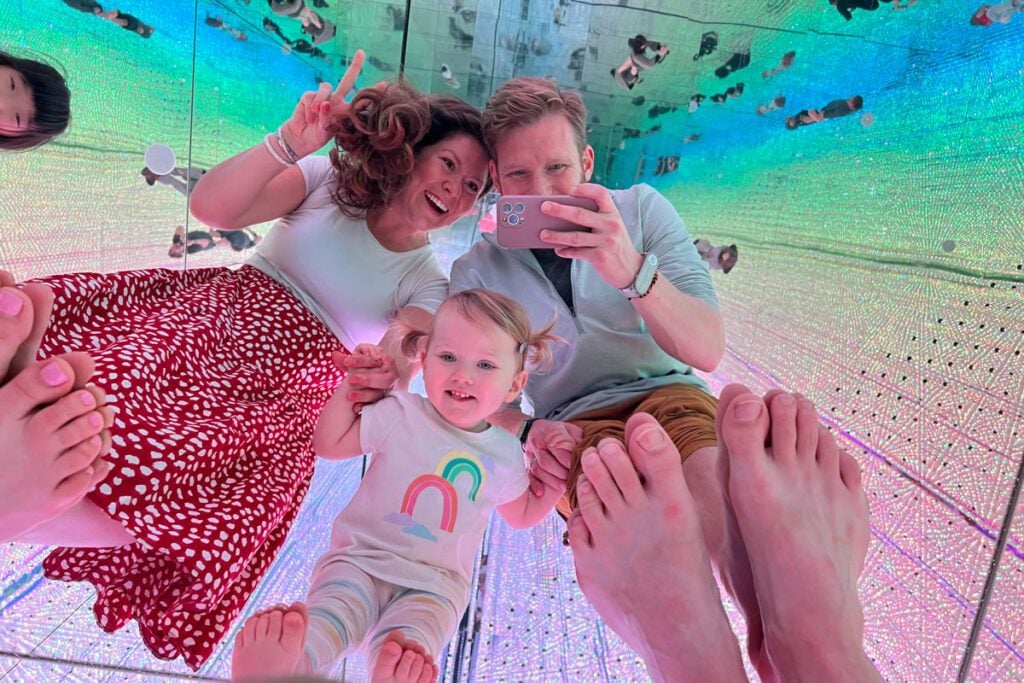
Japan is full of epic nature, crazy things to do that you can’t find anywhere else in the world, and meaningful cultural experiences.
It would be a shame to let your budget limit your experiences in Japan; however, we know all too well that it’s easy to get carried away and spend a fortune without realizing it.
Our best advice for keeping your entertainment costs down is to plan ahead for what big activities you definitely want to do.
Cheap things to do in Japan
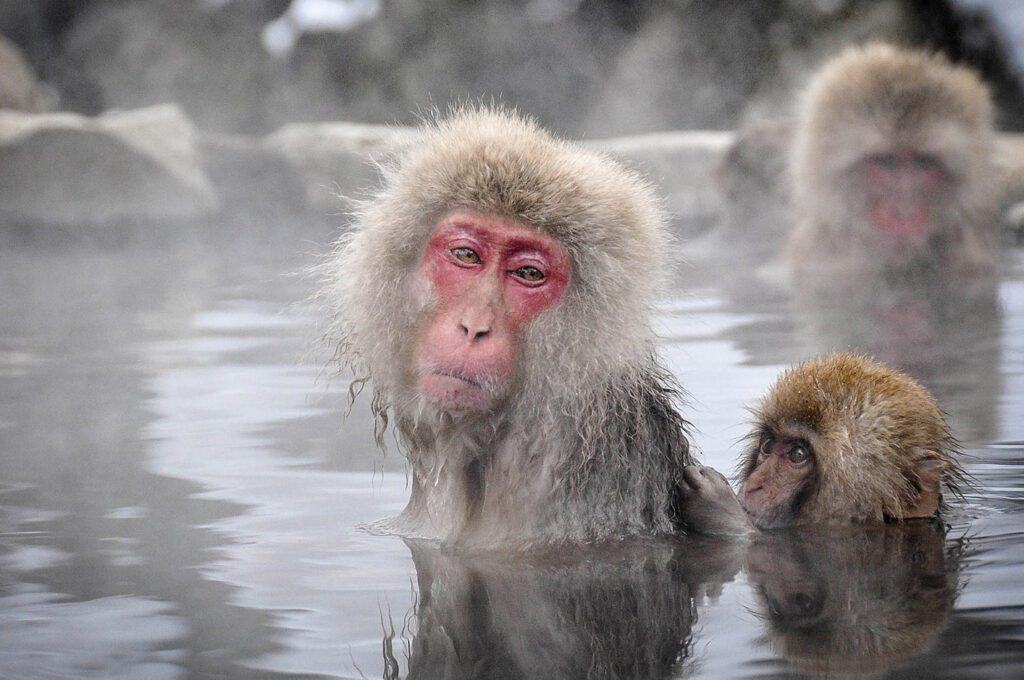
- Jigokudani Snow Monkey Park: Visit the park where snow monkeys soak in their very own natural hot spring. Park entrance: ¥800 (~$5) (pictured)
- Osaka Castle: Enter the 8-story castle surrounded by two moats built in the 15th century. Entrance cost: ¥600 (~$5)
- Hiroshima Peace Museum: Learn about the devastation and rebuilding of Hiroshima after the atomic bomb in WWII. Entrance cost: ¥200 (~$1.70)
Mid-range activities

- teamLab Planets: Immerse yourself in one of the coolest digital art museums in the world. Entrance: ¥4,000 (~$26)
- Shibuya Sky Observatory: Get one of the best views over Tokyo at this beautifully-designed observation deck. Entrance: ¥2,250 (~$15) (pictured)
Splurge experiences in Japan
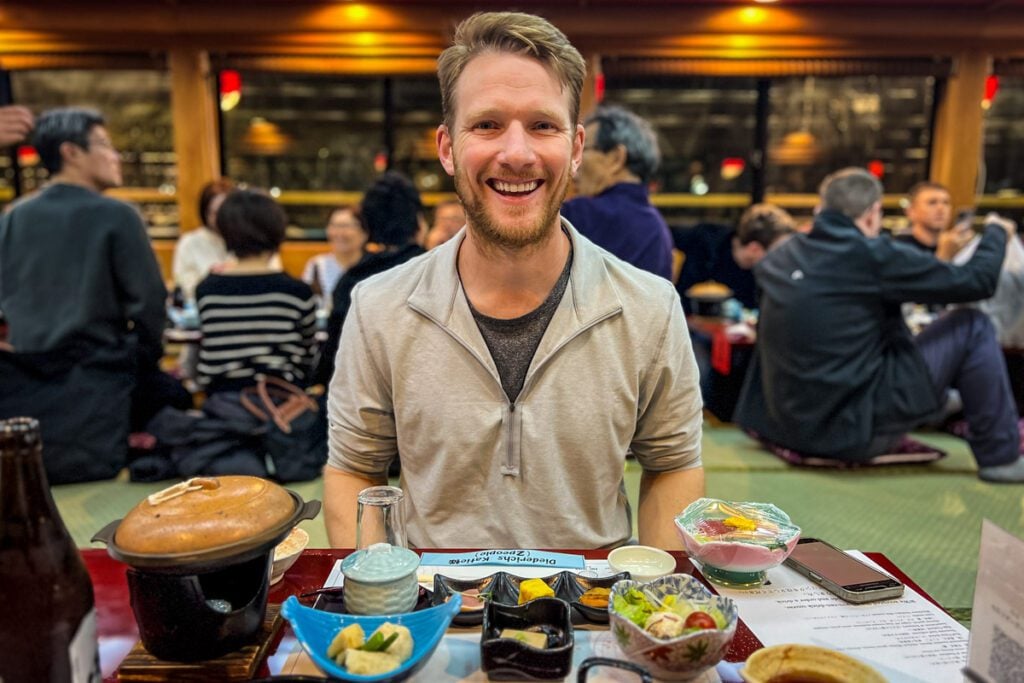
- Arigato Food Tour: walk around a historic neighborhood with a local guide sampling food and drinks from local shops. Tour costs: ¥25,000 (~$170)
- Universal Studios: Osaka’s famous theme park features Super Nintendo, Mario Kart, and the Wizarding World of Harry Potter. Entrance cost: ¥8,750 – ¥10,500 ($58 – $70) Prices vary based on the day/demand.
- Add on Express Pass: We’ve personally never been (yet!), but we’ve heard that the Express Pass is the ONLY way to go to Universal Studios because otherwise you’ll spend a good portion of the day waiting in line. Express Pass cost: ¥19,000 – ¥26,000 ($125 – $170) + the cost of your Universal Studios ticket (Prices for the Express Pass vary based on the day/demand.)
- Mount Fuji day trip: See the most iconic views of Mount Fuji on a guided tour that’ll get you back to Tokyo by dinnertime. Tour cost: ¥12,000 ($82)
- Magical Trip Bar Hopping Tour: Take an evening out with a local guide and see Japan’s nightlife. Tour cost: ¥16,000 ($105)
- Tokyo Dinner Cruise: Enjoy a traditional Japanese meal while cruising down the Sumida river in a boat past the city’s most iconic sights. Tour cost: ¥15,000 ($100) (pictured)
Tips for saving money on entertainment in Japan
There are some really great budget options for entertainment in Japan if you know where to look. Below are our top tips that will save you money on entertainment in Japan:
1. Find free (and cheap!) things to do
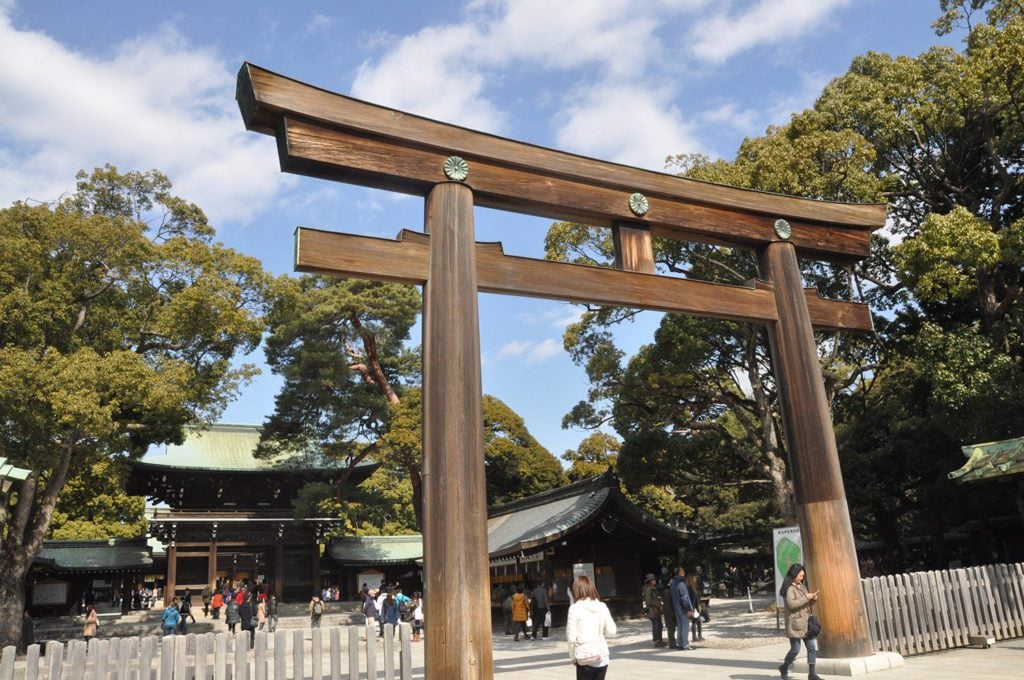
Japan is full of exciting activities and things to do, but trying to do and see everything can easily make your budget skyrocket.
While Japan is not the cheapest travel destination, there are still lots of free and inexpensive activities you can take advantage of to keep your wallet happy!
Here are just a handful of our favorites:
- Find a free walking tour: You’ll meet other travelers and learn stories and information that you’d never find out on your own! You can find walking tours in the bigger cities, like Kyoto Free Walking Tour, Osaka Free Walking Tour and Tokyo Free Walking Tour.
- Visiting shrines and temples: Many temples and shrines in Japan are free to enter and explore. For example, Meiji Shrine, which is not far from Tokyo. Just be sure to read up on the etiquette for visiting before you go!
- Explore historic districts: Wander on foot through the historic districts of the various cities/towns you visit in Japan and get a sense of the history of the place—all without paying a dime (or should we say yen!).
- Wander parks: There are tons of free parks throughout Japan, including Minoo Park outside of Osaka and Arashiyama park on the outskirts of Kyoto.
- Join a Meetup: There are plenty of meet up groups that you can find online. Simply Google “Meetups in [your city].” Here is the Meetup site for Tokyo.
- Explore the markets: There are thousands of markets all throughout Japan. You can’t miss the Tsukiji Fish Market in Tokyo or the Nishiki Market in Kyoto. We also love the walking street/restaurant haven in the Dotonbori neighborhood of Osaka.
- Go to an arcade: Japan has lots of arcades in major cities where you can enter for free and pay a few coins to play games. Be sure to try Pachinko, Japan’s glammed-up version of pinball. We have instructions in our article here.
- Try Purikura: These Japanese photo booths are a quick and fun experience and a great way to bring home a cheap souvenir!
- People-watch on super busy streets: Simply wandering around city streets and getting lost is enough to keep you entertained for several days.
- Go hiking: If you enjoy nature, you’re in luck because Japan has some incredible hiking trails. In our opinion, hiking is one of the best free activities you can do on your travels!
2. Choose your entertainment wisely
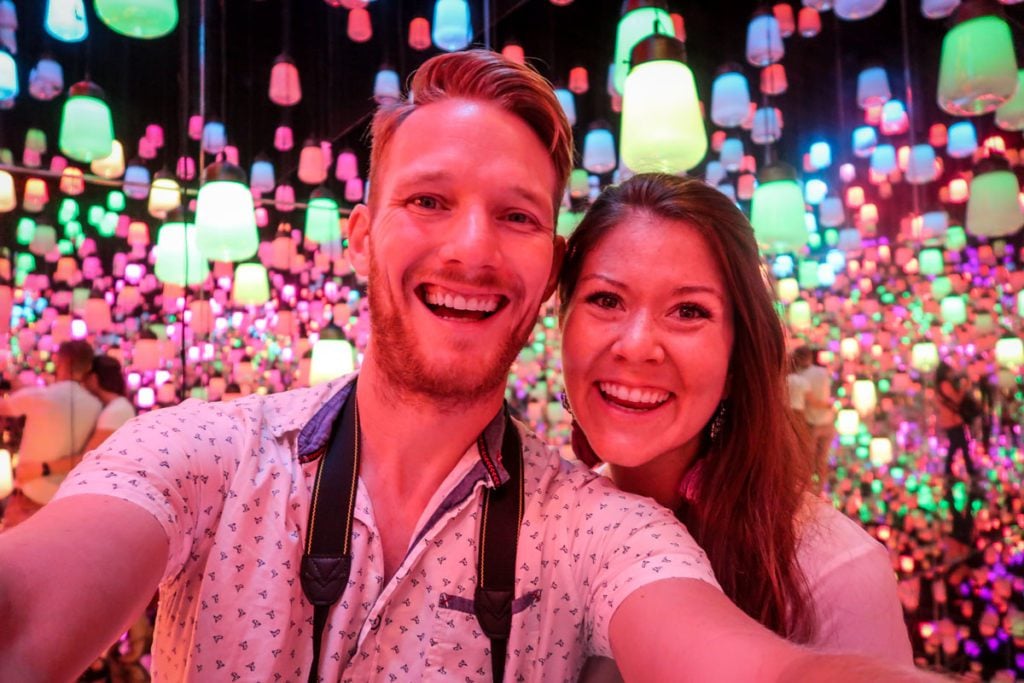
There are some tours and experiences that are well worth the splurge, whereas other activities can be done on your own without a tour group at all!
When planning your trip to Japan on a budget, write down all your bucket list experiences that you absolutely must do.
Now, go through that list and determine which things you can do on your own for less money than tour operators charge. And for those things that you absolutely have to book, like visiting the TeamLab Borderless Museum, Universal Studios, or doing the Alpine Route, write down the prices and keep that in mind as you create your travel budget.
Insider Tip: Compare prices of the same tour between Airbnb Experiences, Get Your Guide, and Klook. Sometimes tours are on just one platform, and other times they’re on all three, allowing you to choose the cheapest version.
It’s okay to have some splurges, as long as you are prepared for them.
Don’t let a small budget make it feel like you can’t do the experiences you’ve been dreaming about. Instead, cut costs in other places, like accommodation or food, to even it out.
Miscellaneous costs in Japan
- Average daily cost: $2-$20+ per person
Don’t forget about all the extra things as these can add up if you’re not expecting them.
Internet: WiFi Hotspot or eSIM
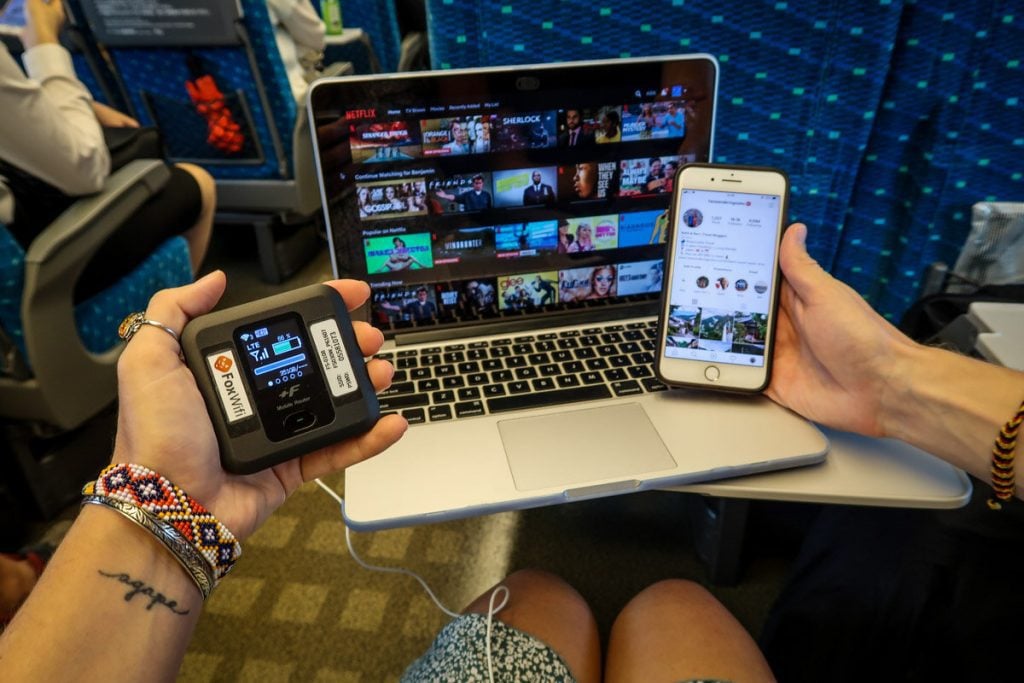
You can choose to either rent a WiFi hotspot (which everyone in your travel party can connect to) or you can each get virtual SIM cards.
- WiFi Hotspot: Depending on how many days you rent it for, a WiFi hotspot will typically cost between $6 – $9 per day. Again, everyone in your travel party can use it so this is not a per person price.
- eSIM: This will be a per person cost since you’ll each want an eSIM on your phone. The company we get eSIMs through offers the following plans:
- 5G for 30 days: $11.50
- 10G for 30 days: $18
→ Not sure which is best? We have an article that compares WiFi hotspots and eSIMs. We’ve used both but think there’s a definite winner for most travelers!
Travel insurance
Don’t forget to budget for travel insurance. Depending on your policy and personal background this can vary.
To give you an example, we found 2-week policies through Safety Wing (our favorite travel insurance company that includes medical) from $24. That works out to be just $1.70 USD per day. Policies can be really affordable, so don’t skip this!
Souvenirs
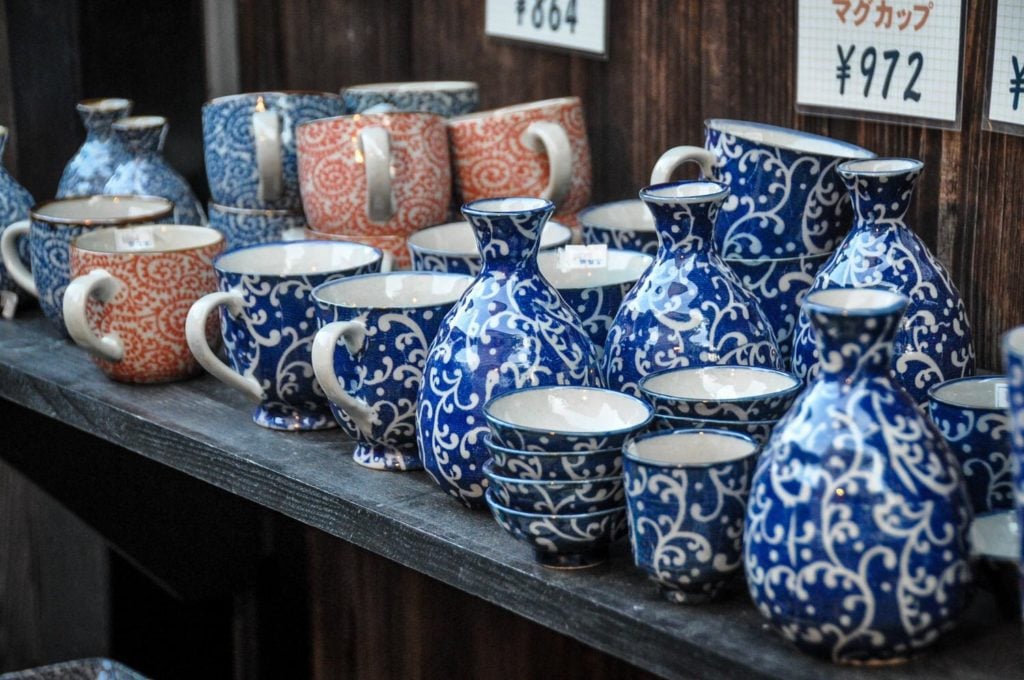
With endless shopping opportunities, it’s easy to get carried away. Before your trip, do some research and make a list of things you want to buy in Japan and include estimated prices.
Now comes the hard part: Stick to that list during your trip! If you stick to your pre-made list, you’ll make sure that you’re only purchasing things that are really meaningful or special. And you’ll stick to your budget!
Sample souvenir prices:
- Souvenir t-shirt: ¥2,500 ($17)
- Souvenir Japanese chef knife: ¥18,000+ ($120)
- Goshuin: ¥300-500 per stamp ($2-$3.25)
- goshuincho is the book that you must get these stamps in, and they typically cost from ¥1,200-¥2,000 ($8-$13)
Japan itinerary & guide
If planning your trip to Japan has you overwhelmed, we have super affordable products that will make your life SO MUCH easier. Trust me.
Depending on what type of itinerary you’re looking for, we have resources starting at just $27 (which is an incredible deal once you’ve seen what it all includes!).
Luggage storage
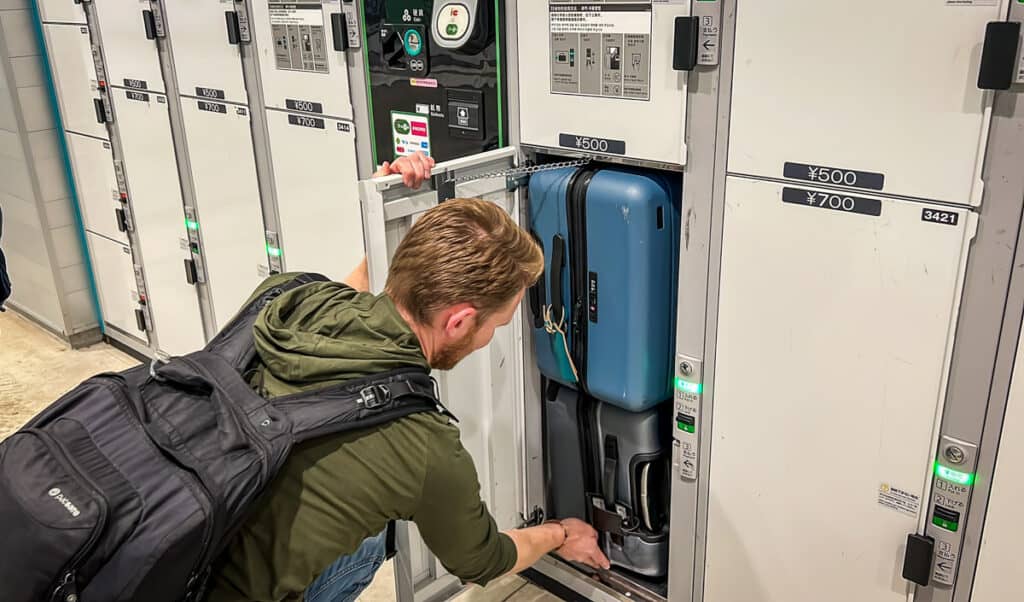
There’s a good chance you’ll utilize luggage lockers at some point on your trip in Japan.
You’ll find lockers at just about every train station, and they are great for storing suitcases or backpacks on days when you want to explore hassle-free (but are between hotels).
The lockers vary in price depending on the size, but here are the general prices you can expect:
- Small: ¥300-400 per day ($2-$2.60)
- daypacks, purses, shopping bags
- Medium ¥500-600 per day ($3.25-$4)
- small suitcases and carry-on bags
- Large ¥700-800 per day ($4.60-$5.25)
- standard suitcase
- Extra-Large: ¥900 per day ($6)
- multiple bags or suitcases
- these can be harder to find, and often there is limited availability, so don’t count on this size
Good to know:
- You can typically pay with coins or by using your virtual Suica or PASMO card.
- These prices are per calendar day (not a 24-hour time period). After midnight, you’ll be charged for an additional day.
- There is typically a storage limit of 3-4 days, so be sure to check this in advance if you need to store your luggage longterm.
- Before locking it, be sure you have all of the belongings you need because once you unlock it, you will need to start over (and pay again).
Luggage transfers
If you plan to use a luggage forwarding system in Japan, you’ll need to account for this expense. Essentially, this is a service where a company will transfer your luggage to your next destination for you so you don’t have to bring it with you on the trains.
Prices range based on the size of your luggage, the company you choose, but will typically be between ($7-$30) per piece transferred. Read more about this service and the costs here.
Depending on your itinerary and travel style, this can be very convenient, or it can be unnecessary.
Personal experience: We have never personally used this service because we prefer to pack light and we often travel to smaller towns that aren’t on the luggage transfer network. Also, depending on which cities you’re transferring luggage between, it may not arrive on the same day.
Unforeseen expenses
I can’t think of a trip we’ve taken where there wasn’t at least a couple of unforeseen expenses!
Things like medication when you come down with a bug, doing an unexpected load of laundry, or buying an umbrella when you’re caught in a surprise rain storm are all likely last-minute expenses.
We recommend adding a 10% “cushion” to your daily budget to account for this so that you’re realistically able to stick to your budget and not completely caught off guard.
Make your personalized Japan travel budget

Follow these steps to determine how much your trip to Japan will cost based on your timeframe and personal travel style.
- First, determine whether you’re on the high or low end of the estimates above.
- Now, multiply your daily expenses by the number of days you’ll be traveling in Japan.
- Next, add in 10% of that number as “padding” for incidentals or miscellaneous expenses.
- Add the cost of a travel insurance policy.
- Do some research on flights from your home city to Japan so you can add the flight cost as well.
Now that you have a total trip cost which includes flights, insurance, on-ground expenses, and some “padding”, write that number down.
This is your total Japan travel cost.
→ Traveling on a budget? These money-saving tips will help you save big in this notoriously expensive destination.
Daily spending budget
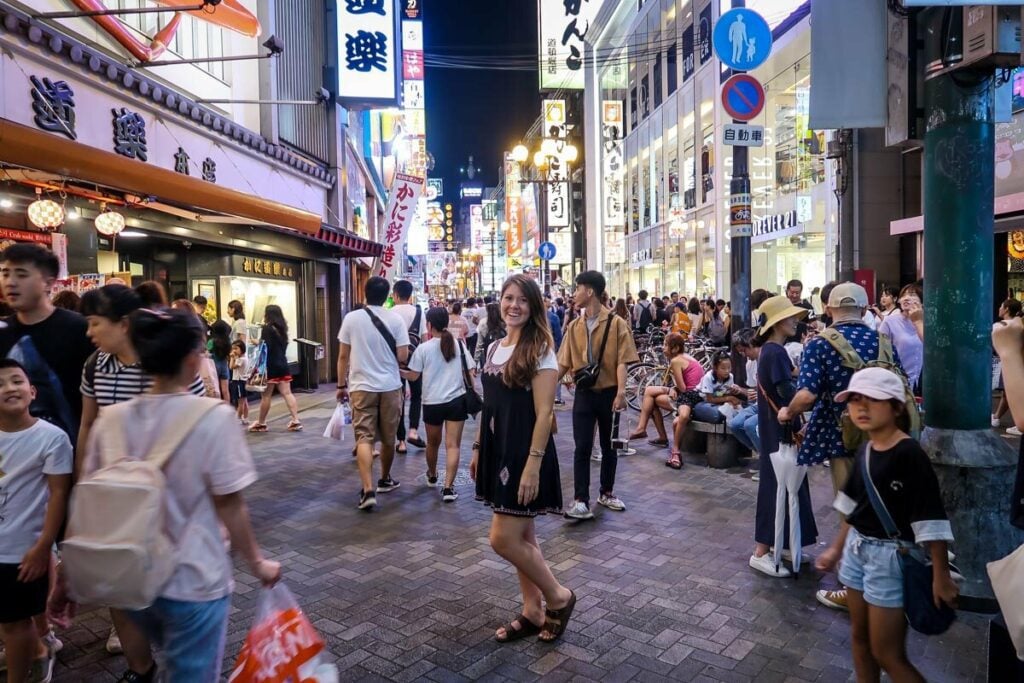
After determining the total cost of our trip to Japan, we then like to come up with our daily spending budget.
- Take the total trip cost you got in the section above and subtract the flight and insurance costs.
- Now you have your total on-ground budget.
- Each time you book a hotel or tour, subtract the cost from your total on-ground budget. Repeat this until you have all your accommodation and pre-booked tours set.
- If you purchase the Japan Rail Pass or book a rental car, subtract the total transportation cost from this number.
- Once you have booked all of your pre-trip accommodation, transportation, and tours, you will be left with the amount of money you have left to spend in Japan. This can be for food, souvenirs, entry fees, public transportation, etc.
- Divide this number by the total number of days you’ll be in Japan. This will give you the amount you have to spend each day.
- During your trip, record each expense and you’ll see how much money you have left to spend that day. If you overspend one day, try to spend less than your goal on the next day to even things out.
General tips for saving money in Japan
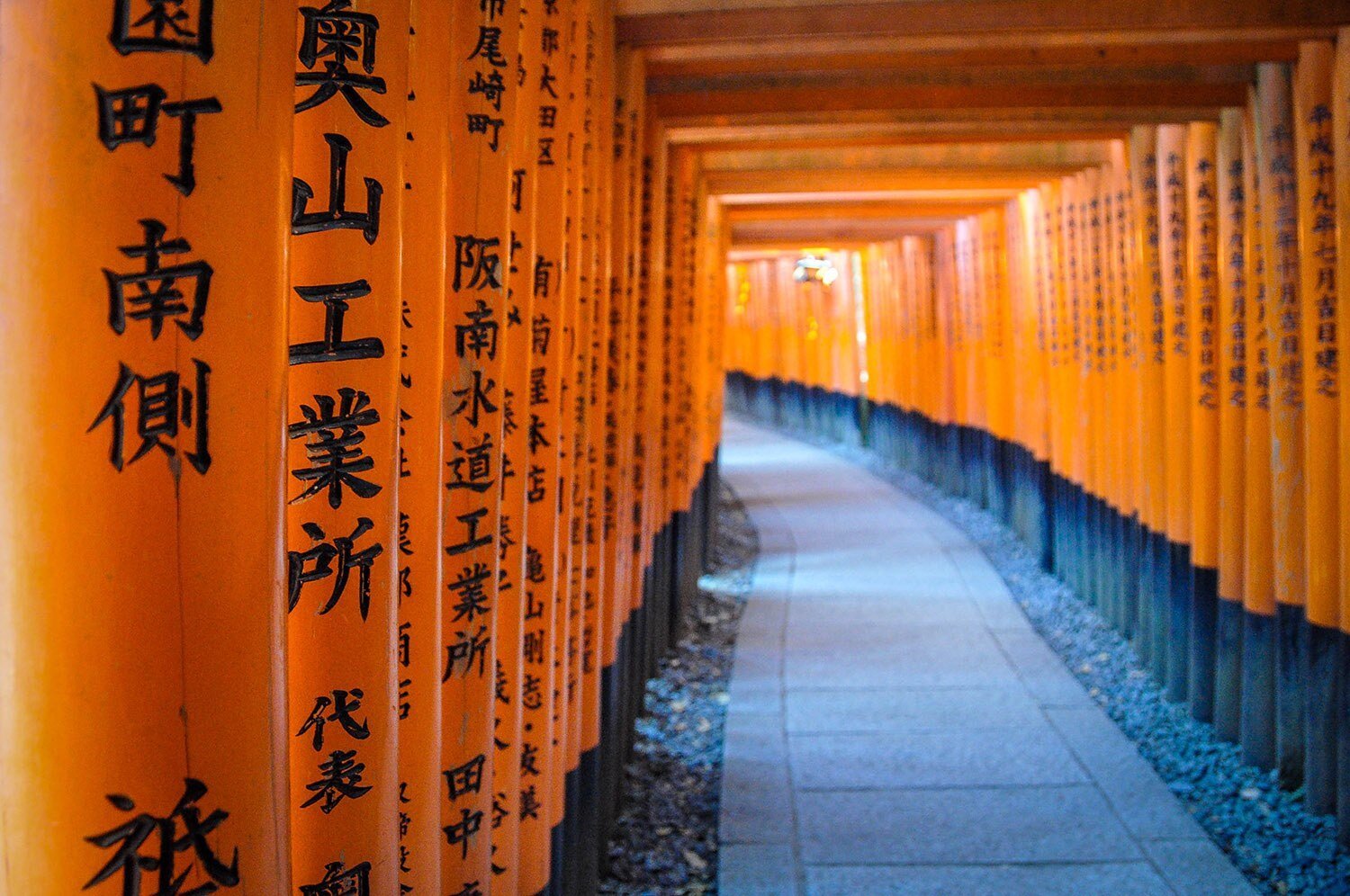
Let’s start with some of the general money-saving tips that will help you keep your budget under control.
Click each tip to see details, or simply keep scrolling to read our advice for each point.
- Travel during low season
- Get off the beaten path
- Understand the conversion rate
- Use ATMs
- Be careful with coins
- Keep your spending in check
- Book early
- Pack right
- Drink from the tap
- Have a plan for Internet
- Get travel insurance
- Don’t tip
- Find cheap flights
1. Travel during low season
Hotel rates vary a lot with demand, so traveling during peak tourist season (especially “Golden Week”) means you’ll pay a heck of a lot more than during less busy times of the year.
To save a lot of money overall, plan your trip for shoulder or low season (ex. we loved visiting Japan in the winter because it was far less expensive and busy).
- High season: mid-March – May (cherry blossom season), summer months
- Low season: late November – March (except around New Years holiday)
Related: To learn more about how to avoid peak tourist season and when you should go instead, read up on the best time of year to visit Japan.
2. Get off the beaten path
Tokyo and Kyoto are great (and must-sees, especially if it’s your first time in Japan!). However, don’t discount Japan’s countryside and smaller towns.
We absolutely LOVE rural Japan and think it is incredibly underrated by most foreign tourists. On top of that, it is much cheaper to eat out and find accommodation in smaller towns than it is in the most touristy cities.
If you’re interested in getting off the beaten path, check out our Japan Hidden Gems itinerary.
3. Understand the conversion rate
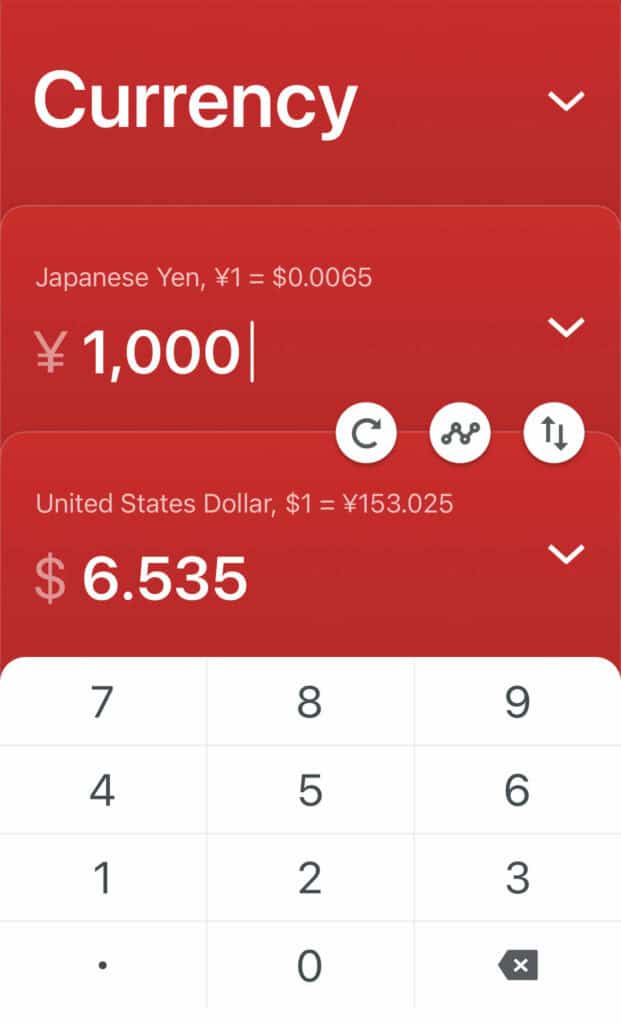
Download a converter app on your phone like this one to see the exact exchange rate for Japanese yen at the time of your trip, so you always know exactly what you are spending.
It can be easy to spend more than you’d like if you don’t know the exchange rate for yen.
4. Withdraw yen from the ATM
Instead of getting a bunch of yen at your home bank or using currency exchange counters, head straight to the ATM when you land in Japan.
ATMs give you the best exchange rate. Plus, if you use a card that reimburses all ATM fees (like the Charles Schwab debit card), you won’t pay anything for this exchange.
This is how we always get local currency. We haven’t done it any other way in 10+ years of travel.
One major question we get asked is how we get local currency in the countries we visit. We have a major hack for this, so listen up…
5. Be careful with your coins
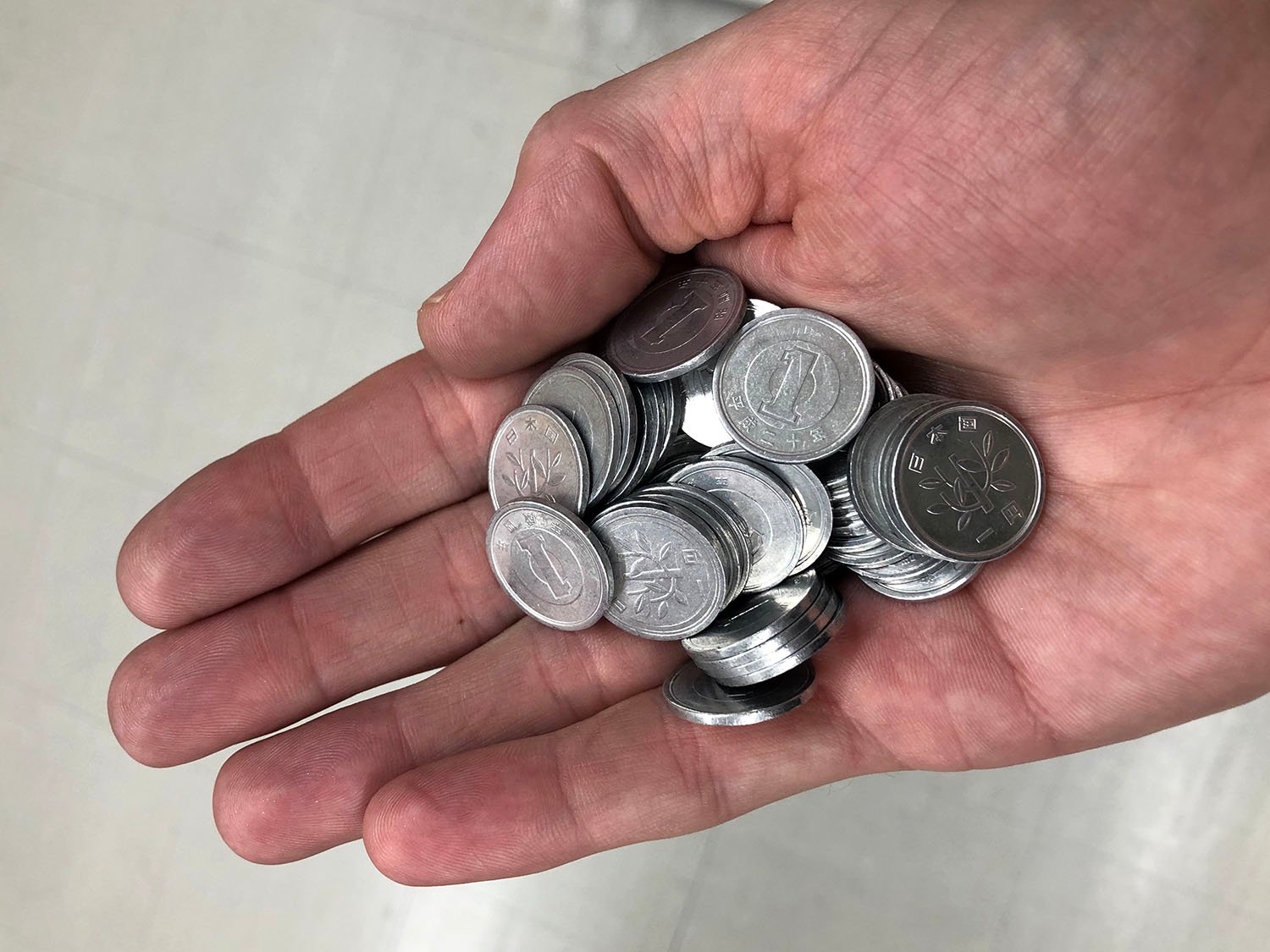
I don’t know about you, but I’m not very careful with coins. Ben throws them in his pockets, we set them on hotel nightstands, I let them get lost at the bottom of my purse. And if I lose a handful of change, it’s usually not a big deal — missing 67 cents isn’t going to ruin my day.
But when traveling in Japan, be more cautious with those yen coins because some of them are worth nearly $5 USD!
Personal example: One day as we were preparing to exit a train, a coin fell out of Ben’s pocket and into the seat. He dug around for it a little, and found that it was a 500 yen ($4.60 USD) coin! Good thing we didn’t just leave it! That night, Ben emptied his pockets and we counted $32 USD worth of coins — that’s crazy! After that, we decided we should probably not be so cavalier with those coins, and we got a pouch to keep them safe in.
Insider tip: We’d recommend bringing a coin pouch, or getting one in Japan as a souvenir. Bonus points if it has a way to separate the small coins from the ones that are worth more!
6. Keep your spending in check
We recommend coming up with a budget before your trip so you don’t accidentally overspend.
While on your trip, use an app to record your spending and see how well you’re staying on top of your budget! We find it’s much easier to overspend when you don’t know how much it’s all adding up to.
You can do this in any way that works for you:
- use your notes app to jot down expenses
- use a software or app, like Monarch
- use the calculator in your phone to subtract each payment from your daily allowance (and restart it each day)
- just use your best judgement to gauge how close you are to your daily budget goal
Remember, it’s all about balance. If you go over our budget today, try to make up for it tomorrow.
7. Book early
Japan is a destination that we’d recommend booking earlier than you typically would for other trips.
When you book earlier, you’ll have a better selection of accommodations to choose from, making it easier to get a good deal.
There are also certain activities that must be booked in advance and you won’t want to miss out.
→ Psst! We created a free Japan booking timeline that should help!
8. Pack right
Put some extra thought into what you pack. While there are many things you can easily get once you get to Japan if you forget them, there are certain items that are very hard to come by. And if you do find them, they can be quite expensive.
Some examples of items that are hard to find or expensive in Japan:
- Menstrual products
- Deodorant
- Sunscreen
- Shoes or clothes in larger sizes
Save yourself the time, hassle, and money by checking out our Japan packing list so you don’t forget any essentials and make a costly mistake!
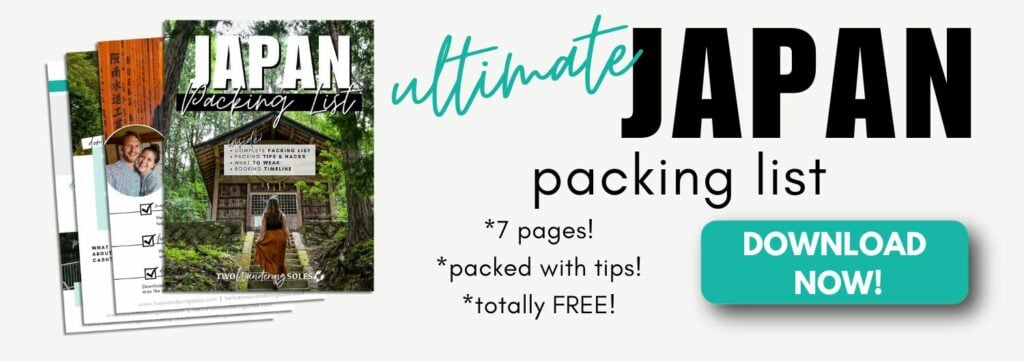
9. Drink water from the tap
I’m gonna keep this one short because hopefully it doesn’t require much explaining.
The tap water in Japan is totally safe to drink, and for the most part it tastes good too! Bring a reusable water bottle (I’m obsessed with my Owala bottle) with you and fill up to stay hydrated.
Not only is this going to help your budget, but you’ll save a ton of plastic waste. Virtual high five!
10. Stay connected to the Internet

This might seem like a strange tip, but stick with me…
Being connected to the Internet will help you get around on transportation with few mistakes, hence avoiding those extra swipes on your metro card. See which transportation apps we definitely recommend you download! It will also help you find nearby restaurants and filter through the expensive ones.
We have an entire article that goes over the differences between a SIM card and a pocket WiFi device so you can choose which one is best for you.
11. Get travel insurance
It’s never fun to think about something going wrong on your trip, but let’s get uncomfortable for a moment…
A medical emergency, stolen valuables (though this is highly unlikely in ultra-safe Japan!), or missed flights can all leave you with a gigantic bill. Travel insurance is much less expensive than you might think, and it can ensure you’re protected in some of these situations.
Before you start shopping for insurance, read this article that goes over all of the things you should look for before you hit “purchase”.
12. Don’t tip
You won’t have to account for tipping in your budgeting because it is not customary in Japanese culture, and in some cases it can even be seen as slightly offensive.
→ Related reading: Japanese etiquette you need to know before your trip!
How to find cheap flights to Japan
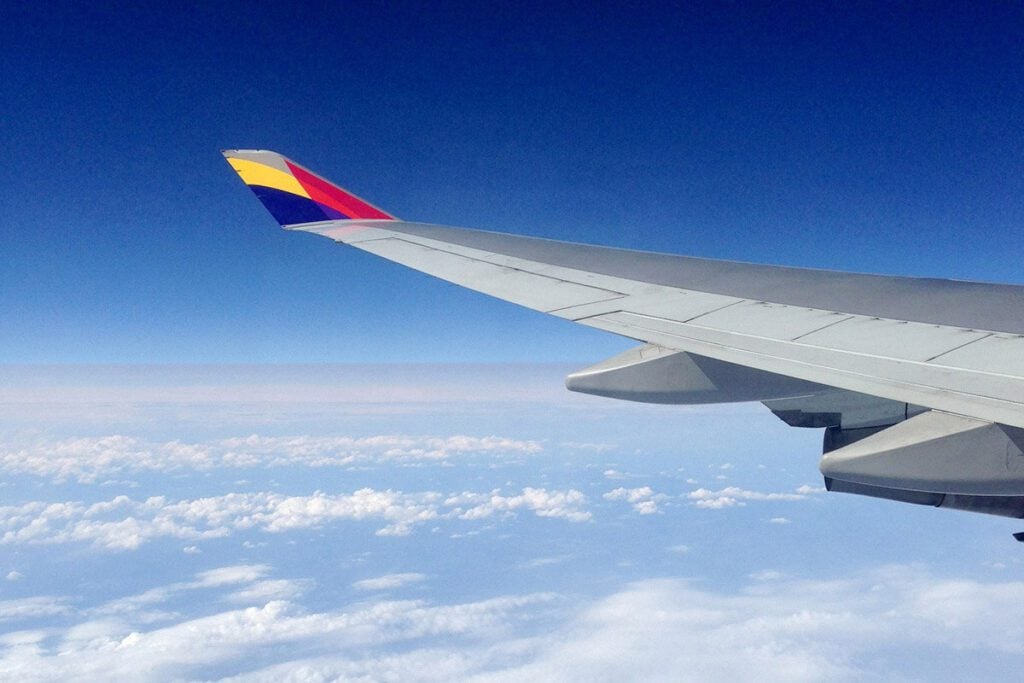
If you’re coming from Europe or North America, your flight to Japan itself is going to be a significant portion of your travel budget. You’re flying halfway around the world, after all, so it is to be expected.
But fear not, we have some hacks for finding airfare to Japan that doesn’t make your eyes water.
1. Sign up for a flight deals newsletter (& set an alert for Japan!)
Sign up for a flight deals newsletter, like Daily Drop Pro, so you can get alerted when there are really good deals on flights from your home airport to Japan.
2. Experiment with different hubs
If you are simply putting your home airport in the departure destination, you may be missing out on some really great deals.
Play around with setting your departure for a different airport and see what comes up. Sometimes getting two separate flights can save you a lot of money. But on the flip side, sometimes the layover times make it not worthwhile at all. You just have to play around a little and see what flights you find.
Theses hubs often have good deals to Tokyo and/or Osaka:
- SFO: San Francisco
- SEA: Seattle
- ICN: Korea
3. Monitor prices
Keeping an eye on the flight prices will help you understand what’s an average flight price and what’s a good deal.
4. Travel during Off-season
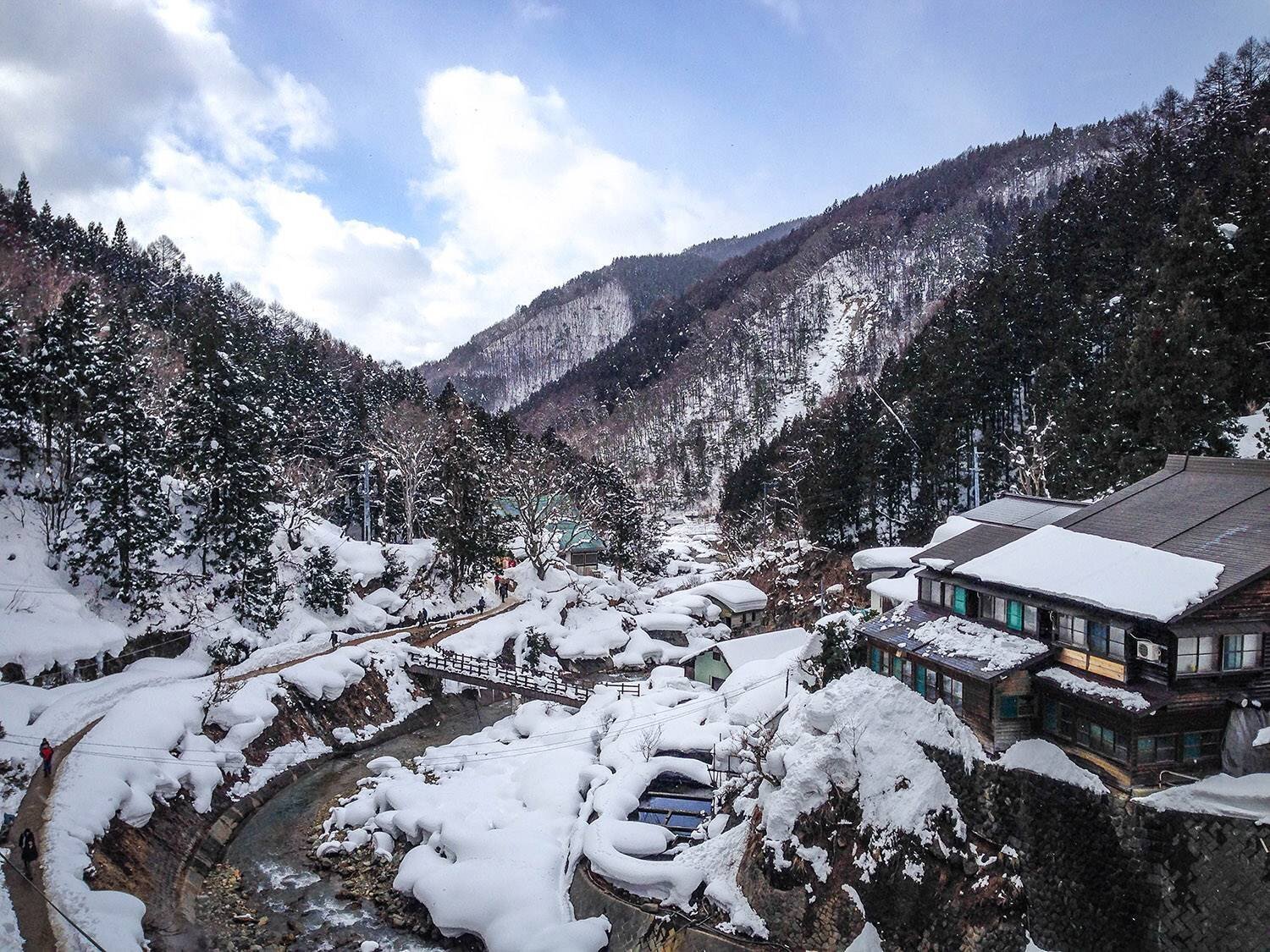
Want to see cherry blossoms in Japan? You, me, and just about everyone else in the world!
Springtime in Japan is beautiful, but also very crowded. This means the demand for flights is at its annual high, and peak prices can be expected.
If you fly to Japan during less popular times of the year, like the winter or even late fall, you might be able to snag a steal!
Related articles:
- Winter in Japan: What to expect & top places to visit
- Autumn in Japan: Best places to see Fall Foliage
5. Look at flying into Osaka instead of Tokyo
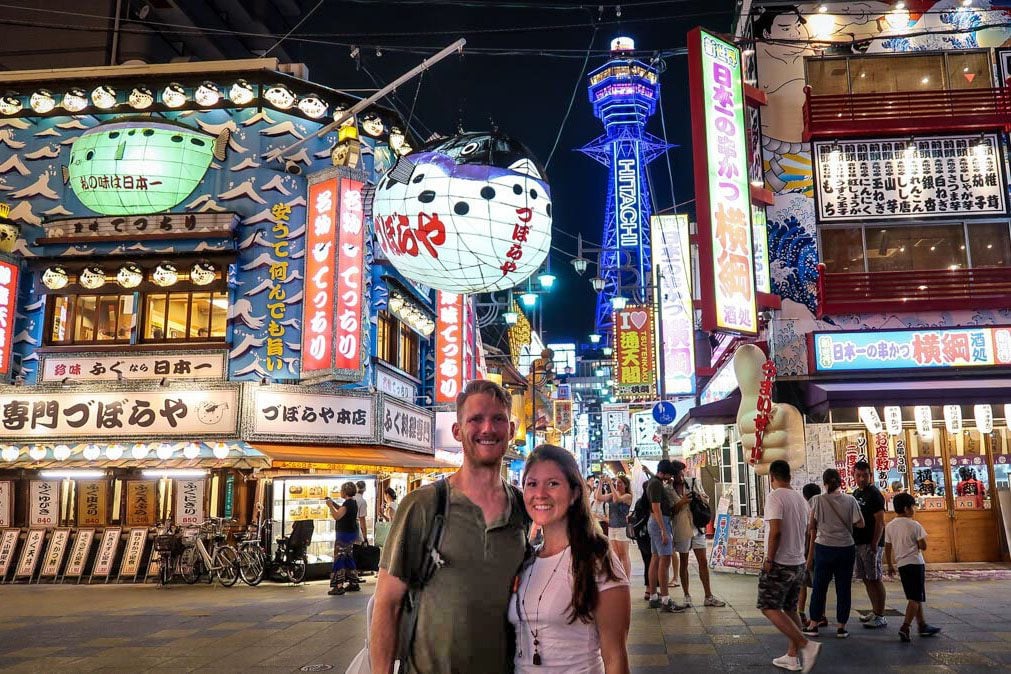
Tokyo might be your first thought when it comes to flying to Japan, but try searching for other international airports as well.
On one of our trips, we flew into Osaka because the price was significantly lower. Plus, it’s a great city to use as a hub, as there are lots of things to do in the city as well as plenty of day trips from Osaka.
6. Fly in and out of different cities
If your itinerary is flexible, try different combinations when it comes to where you fly in and out. This can also save you a long train ride if you plan to visit multiple places.
For instance, we wanted to visit both Osaka and Tokyo. Instead of flying in and out of the same city, we flew into Osaka and out of Tokyo, saving us an entire day of travel to get to the airport.
7. Consider signing up for a new credit card
Even if you score a cheap flight to Japan, it’s still going to set you back a good chunk of change. Before purchasing big flights, like this one, we usually think about signing up for a new credit card. Typically there are bonuses if you spend a certain amount within the first months of signing up. And the flight alone should help you get part way there.
Good news: Credit cards are also widely accepted in Japan. True, you’ll need cash for smaller restaurants and shops, but many places take plastic so you can earn points on your trip too!
8. Use points
Flying to Japan is a long haul for many travelers coming from Europe or North America. This makes it a good opportunity to use airline points to pay for some or all of your tickets.
Note: We are not financial experts, and we cannot give personalized advice. If you are looking into a new credit card, check out this article where we mention some of our favorites.
→ Want more? Check out more tips for how we find cheap flights around the world!
Plan your trip to Japan
After 3 trips (and counting!), we’ve fallen head over heels for Japan—and we’ve created TONS of resources to help you plan your dream trip. Start with our Ultimate Japan Travel Guide and be sure to check out these helpful articles:
- First time? Our Japan Trip Planner walks you through everything you need to know.
- Use our Japan Rail Pass guide to determine if getting a train pass is optimal for your trip.
- Here’s our curated list of the best things to do in Japan—from iconic sights to once-in-a-lifetime experiences.
- Not sure where to go? Our Japan itinerary ideas will help you map it all out.
- Foodies, rejoice! This guide to what to eat in Japan will have you drooling before you land.
- This guide to what to wear in Japan (and what not to wear) will help you blend in.
- Use our ultimate Japan Packing List to make sure you don’t forget anything.
- Before you go, brush up on these essential Japan travel tips (including major do’s and don’ts!).
- Avoid awkward moments by brushing up on Japanese etiquette.
Still have questions? Drop us a comment—we LOVE helping travelers plan unforgettable trips to Japan!
Perfect Japan itinerary
Want the perfect itinerary planned for you?

If you don’t have a ton of time to spend planning your Japan itinerary (or you just don’t find travel planning fun), we’ve got something you might be interested in…
We created the ultimate done-for-you Japan itinerary that is packed full of all sorts of tips we’ve gathered from 3 trips to Japan as well as literally hundreds of hours of research (no exaggeration).
We have both an off-the-beaten path route as well as a classic itinerary that hits the top attractions (perfect for your first visit to Japan!).
Don’t miss your chance to grab our Japan packing list!
This FREE PDF download includes everything you’re going to want to pack for your Japan trip, including what NOT to bring, plus tons of insider tips!
Just enter your email and we’ll immediately send you access instructions!
Save this article on Pinterest for later!
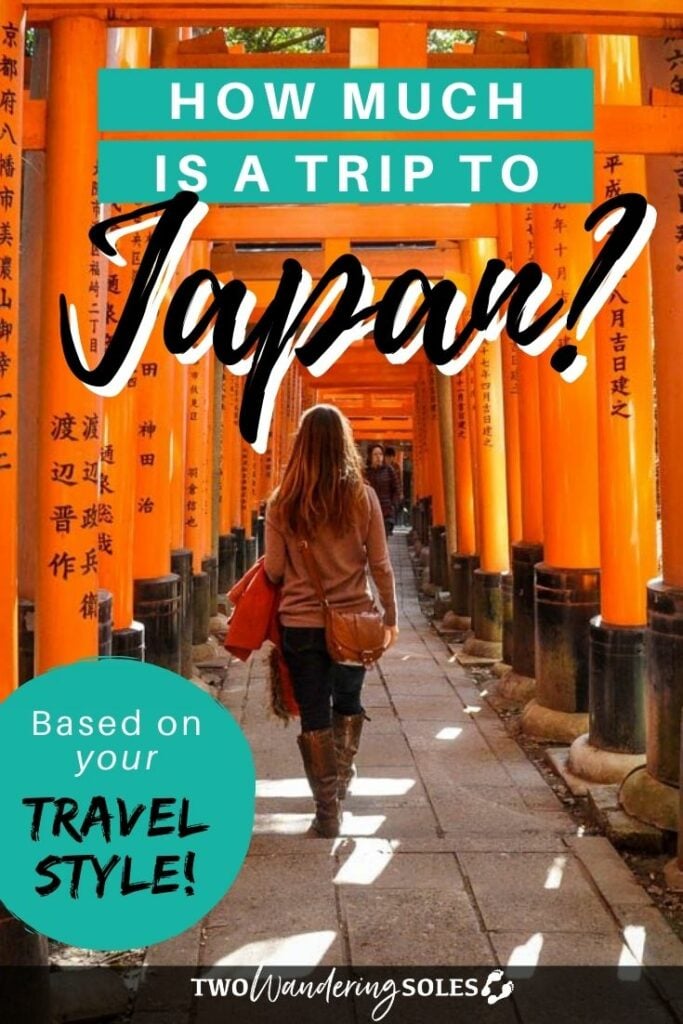
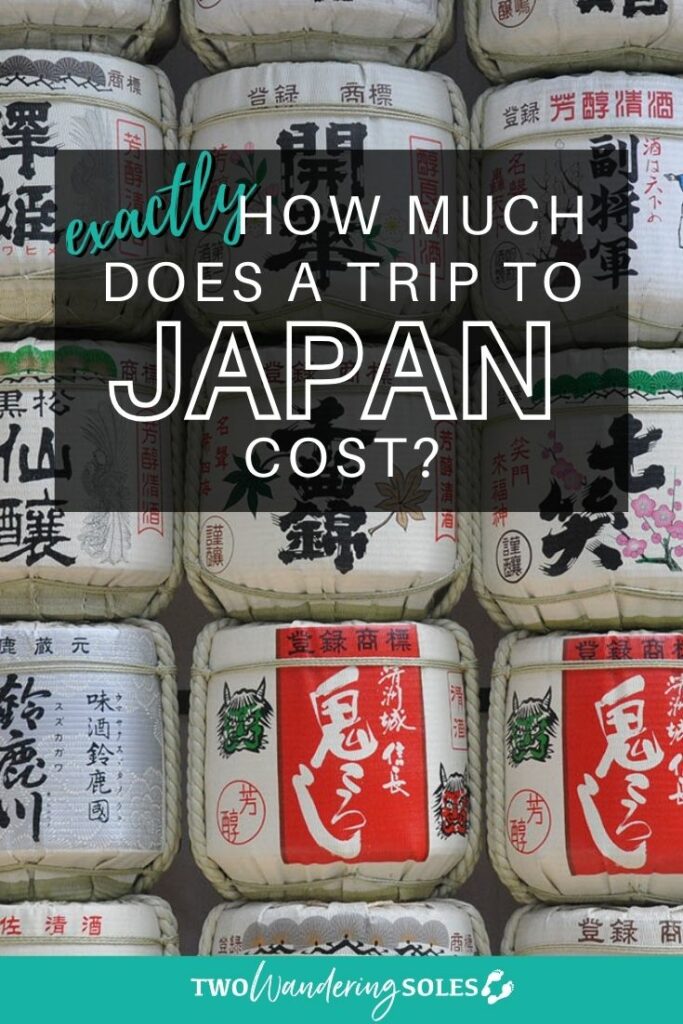

We want to hear from you!
What is your biggest question about costs in Japan? Do you have any money-saving tips you’d like to share? Comment below!

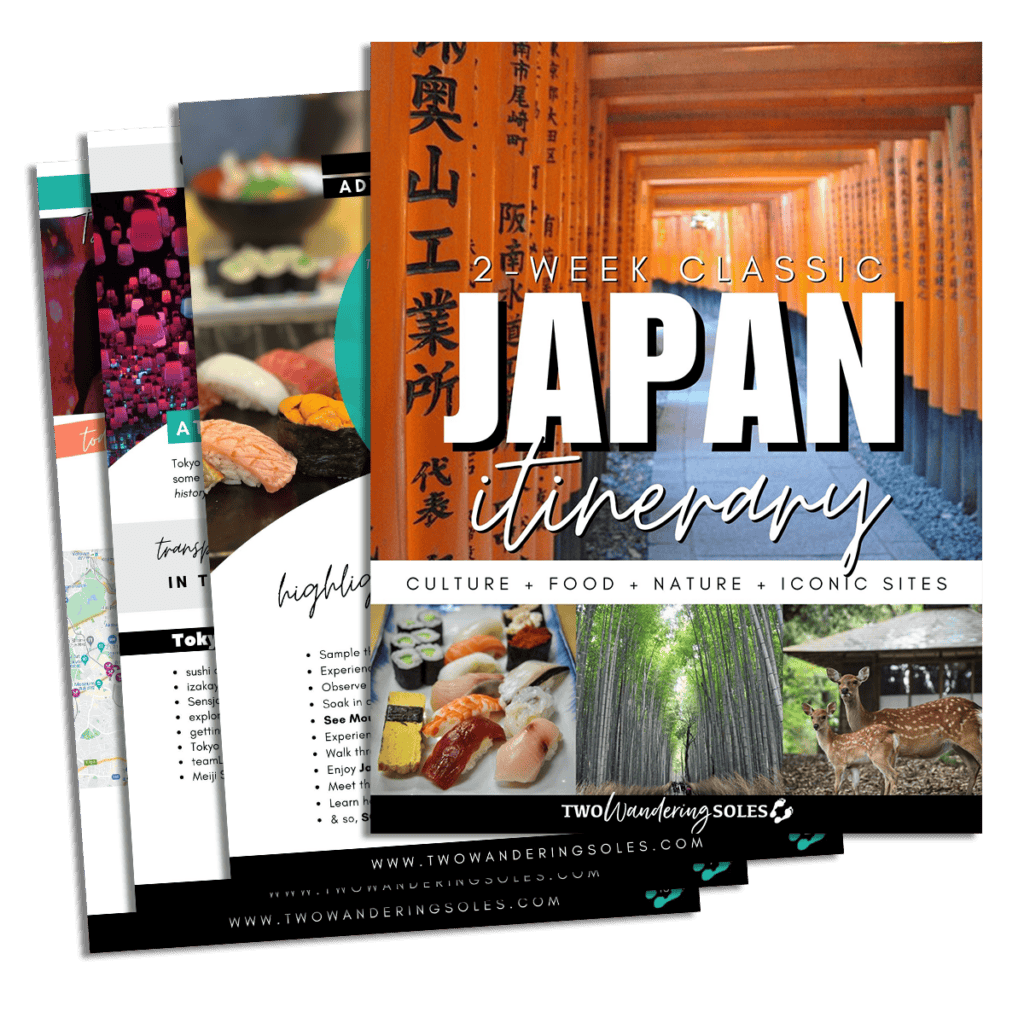
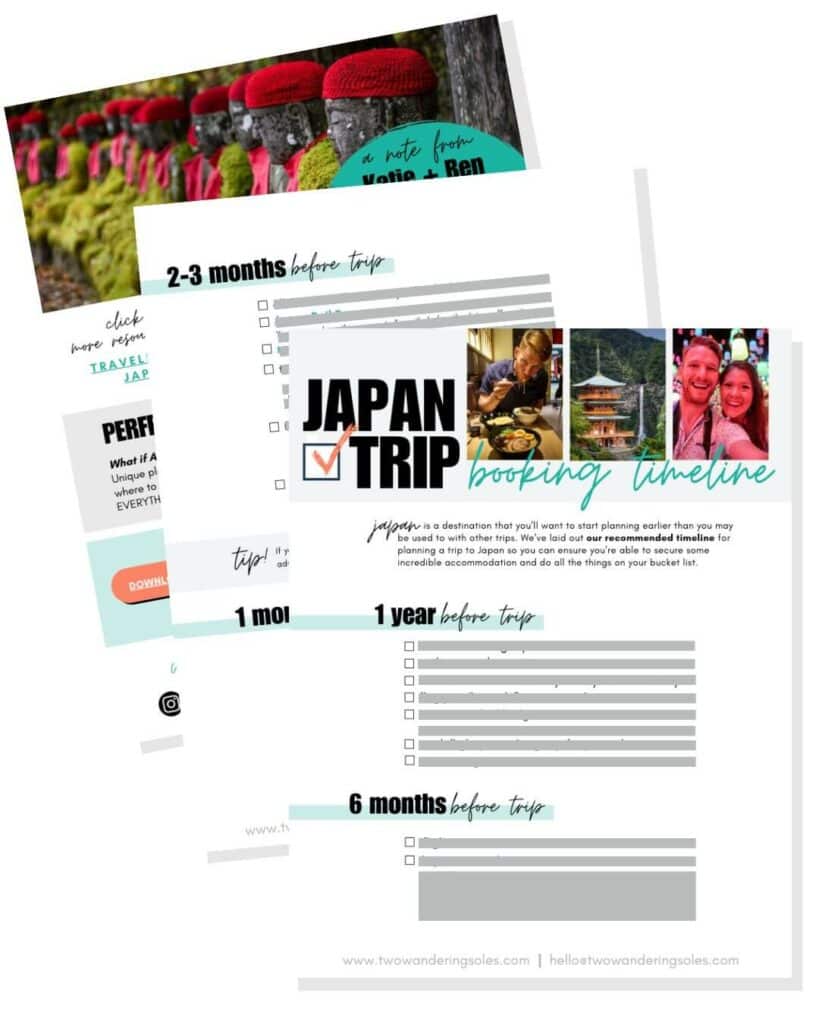
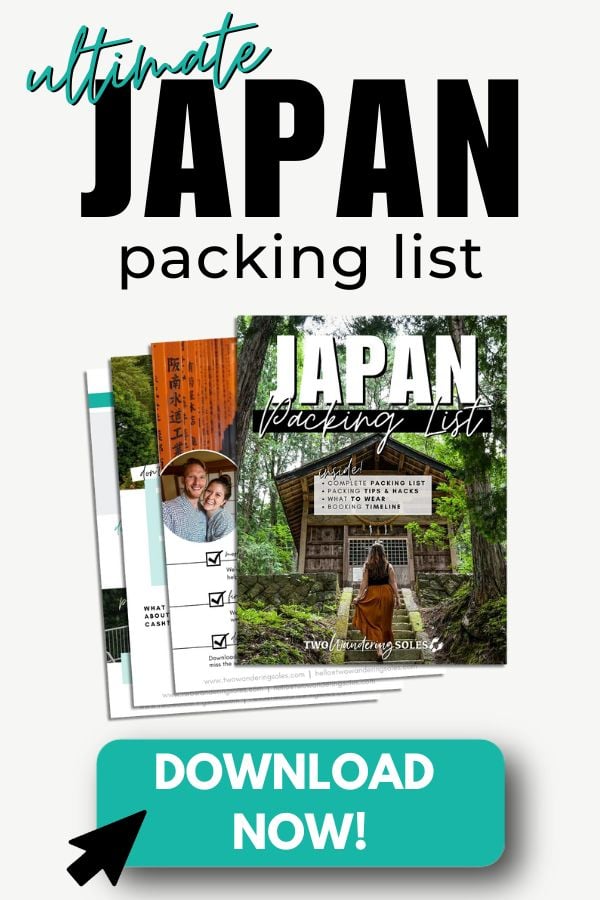
You’re doing a great job — really enjoying your posts!
i love japan and its culture. wanna travel there. thanks for sharing this great article.
I am looking for a local agent or plan a trip to Japan for the cherry blossoms minimum 10 memebers
I think that one-week budget is kind of enough to have a good trip to Japan. The thing that concern us most is its costing. The japan is believed to be one of the costliest places to visit but hiring a good travel agent company will let us know how to save our money and travel there in low budget.
Thank you so much for all your helpful tips about Japan. Very cool you’re from MN and studied Jour/Graphic Design – me too! We’ve only travelled overseas for work before and stayed in the same city. If you stay in a hostel or capsule hotel is there a way to safely store your luggage during the day or should we plan to backpack everywhere?
Thank you so much for all of the info and tips! Is Japan credit card friendly or should we plan on using cash for most purchases?
Hi! This is so useful, thanks a lot. Plan to make a trip in may with my husband & 18 yr old son. Appreciate it!
No problem Joe! Glad you found this useful. Have a fun trip!
Notice that you didn’t include the cost of flights!? Is there a reason you excluded this-just wondering how you to/from Japan
Hey, great question. We didn’t include airfare in the budget because we flew from South Korea and our flights were very cheap – less than $300 for a roundtrip. We realize that many (if not most) people using this budget will be flying from much further, so those numbers would not be relevant to them. Flights vary so much on how far in advance you book them to where in the world you’re flying from, and since our readers come from all over the world, it’s hard to give a number in a budget. We decided instead to include only the expenses we incurred in the country so that this budget is useful to anyone no matter where you’re flying from. We should specify this though in the budget, and will make those change shortly. Thank you for pointing this out!
My first trip to Japan was with a band. Our guitarist is Japanes, so we were being directed, but in 2009 I only spent $AUD2,000 over two weeks, and that included airfare. (Jetstar 2 for 1 flights.)
Hey there, that’s great to hear you were able to travel Japan on a budget too! It can certainly be done cheaper than we did, but we wanted to see as much as possible in 8 days, so transportation added a lot of cost! And we were happy with spending just under $1,600 for 2 people 🙂 That said, it has been one of the more expensive countries we’ve visited in the last few years!
Cheers!
Thank you for the amazing advice for japan. I was wondering where did you buy the japan Rail Pass in Korea?
Hi Angela, I’m glad it’s helpful! You can purchase your JR Pass online at http://www.jrpass.com/. The vouchers are sent via FedEX from France (random!!), and are sent out the day you order them, so they get to you very quickly. We ordered our tickets on a Wednesday. Our flight was on Saturday and we were worried that they wouldn’t make it to us in time, but a package arrived the next day with our tickets! I’d recommend ordering them with a bit more time than we did though just so you aren’t worried! Once you get to Japan, you can then exchange them for the actual pass at any major JR Station. This saved us a ton of money. Hope this helps. Have a great time in Japan!